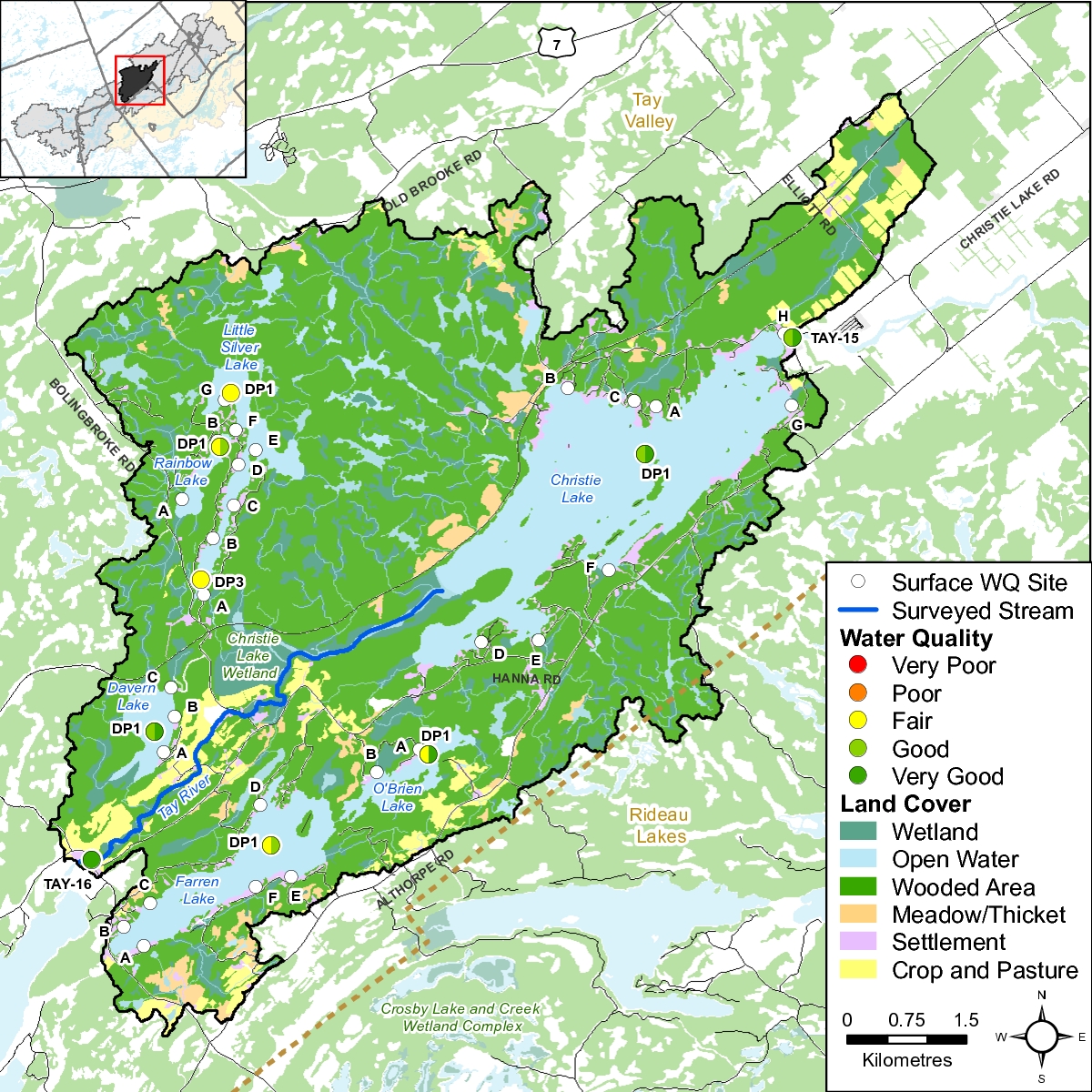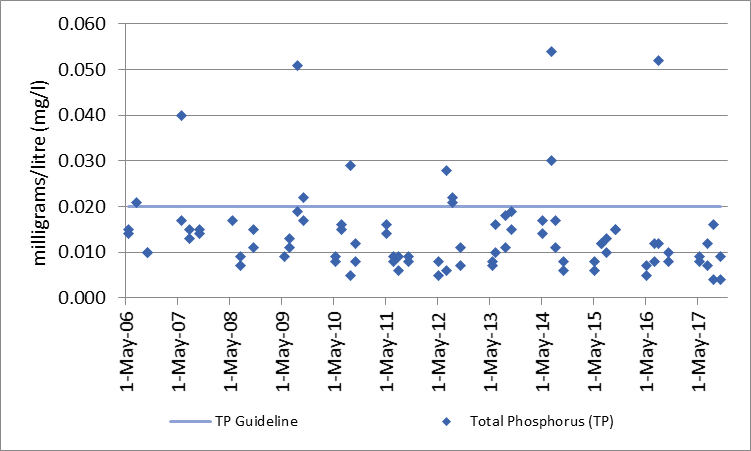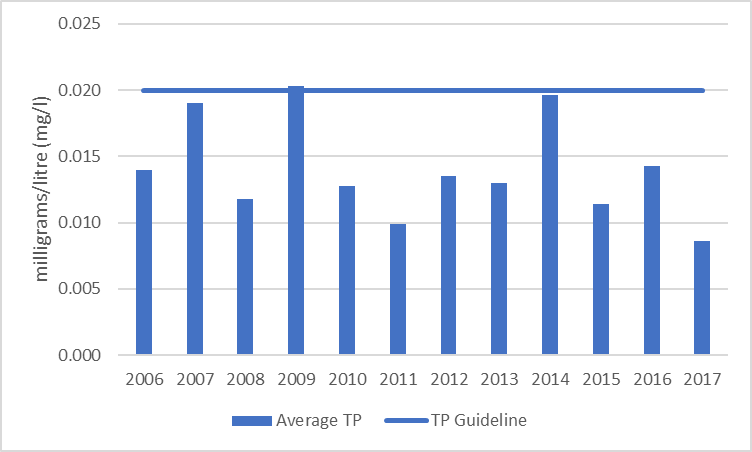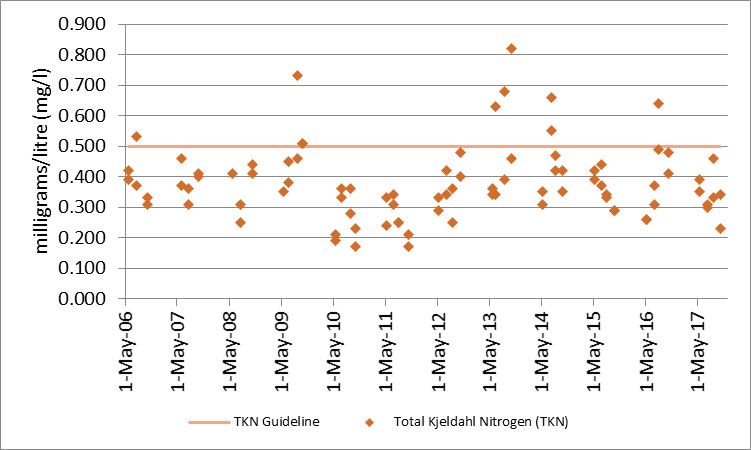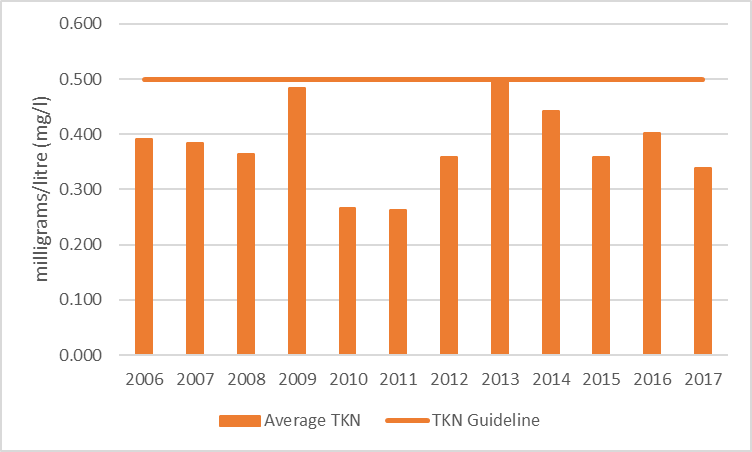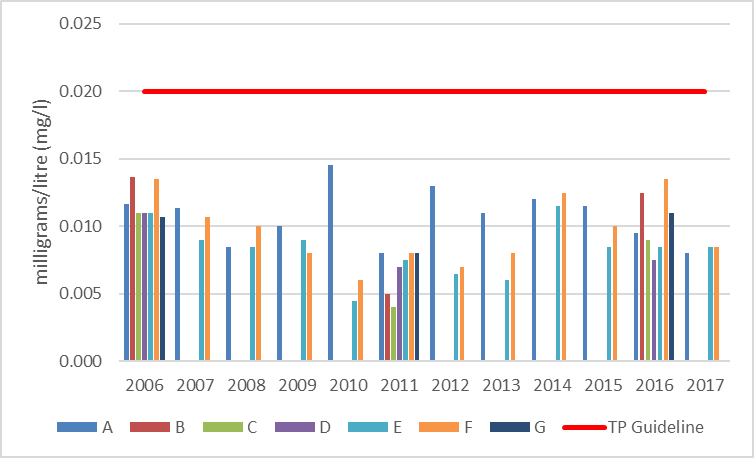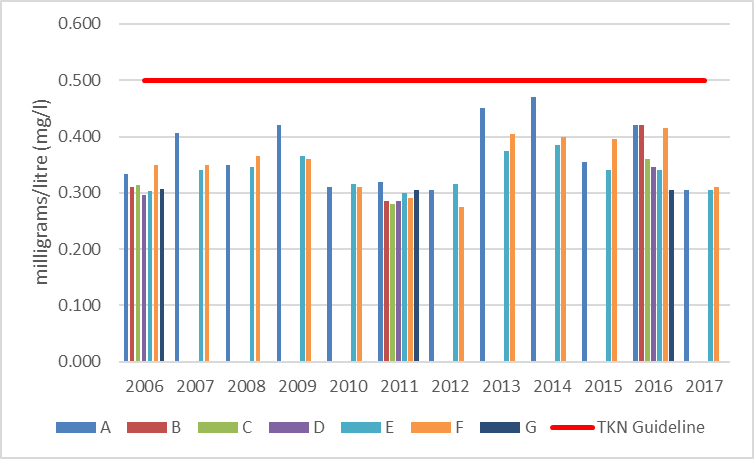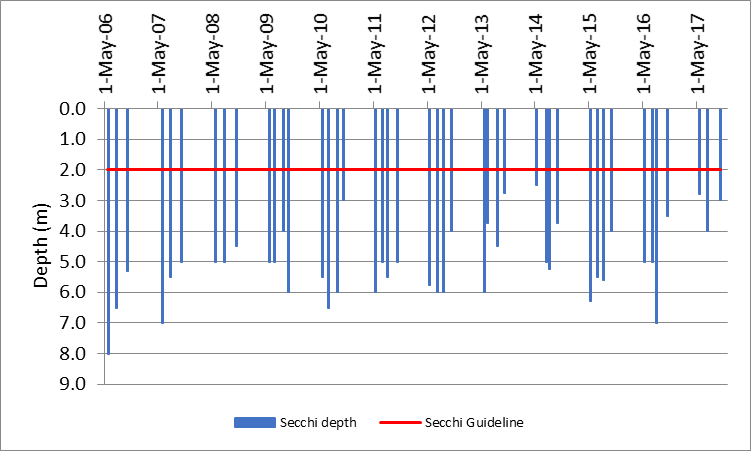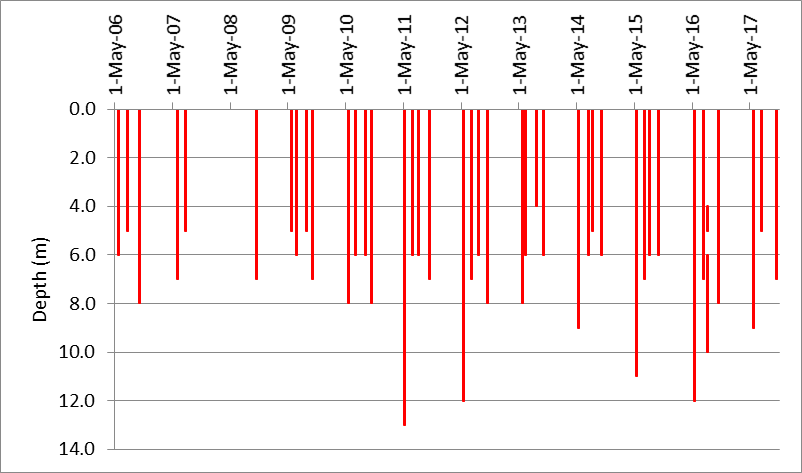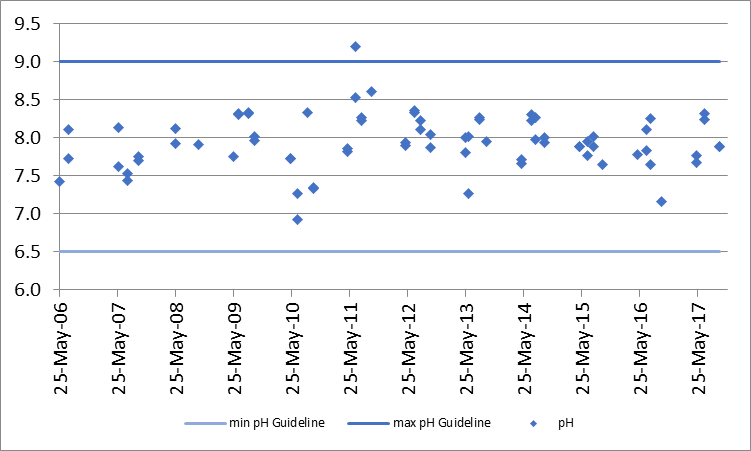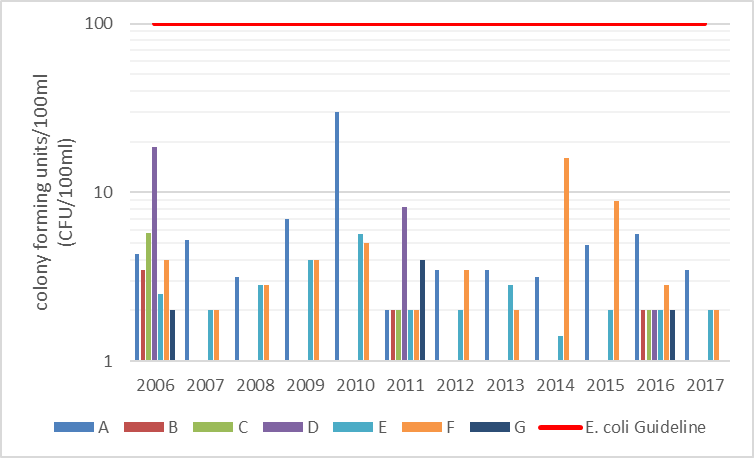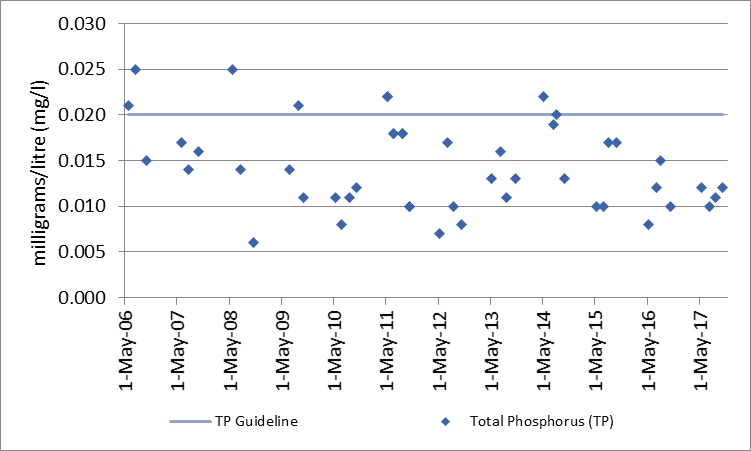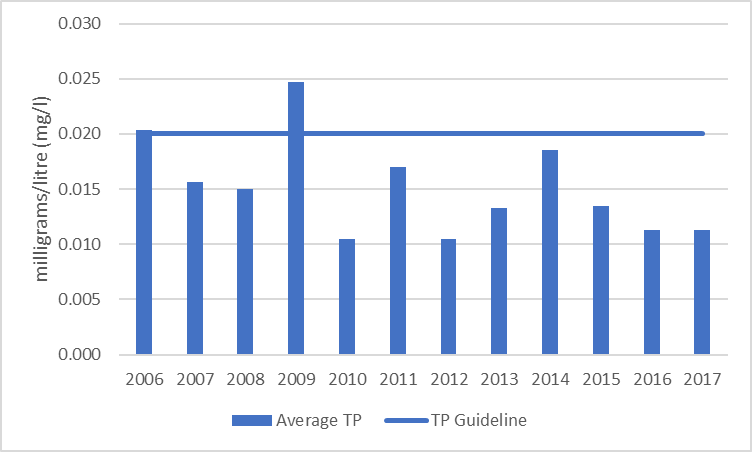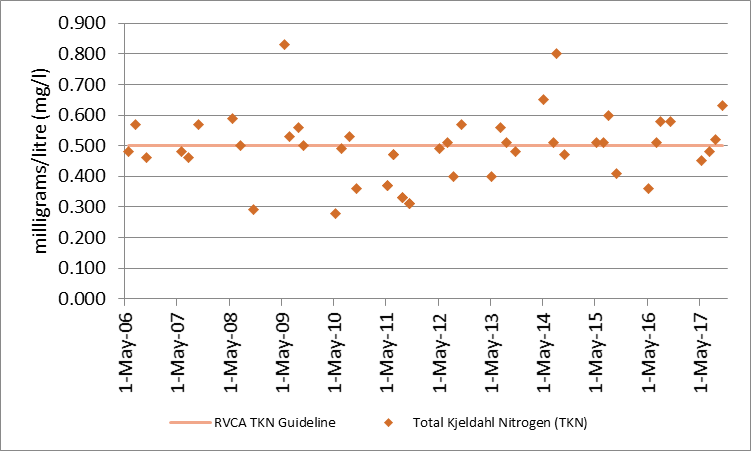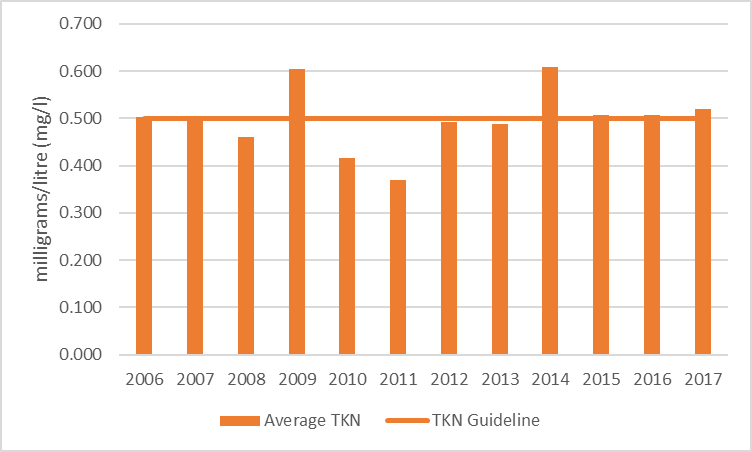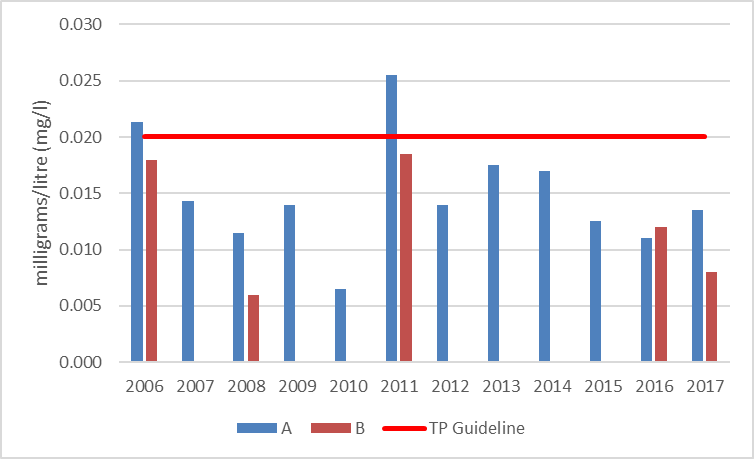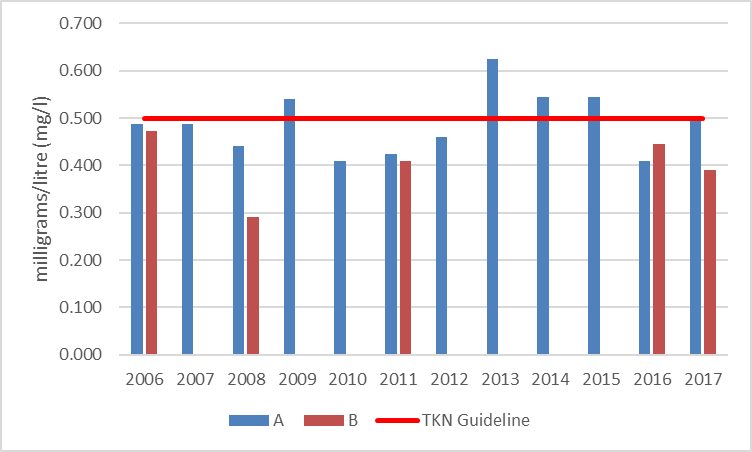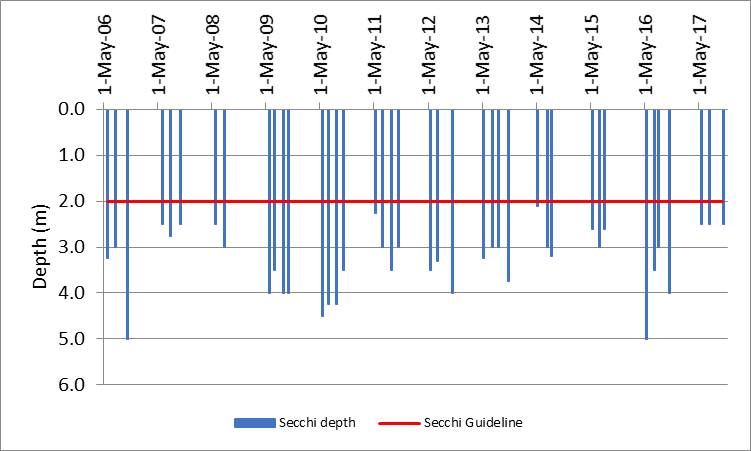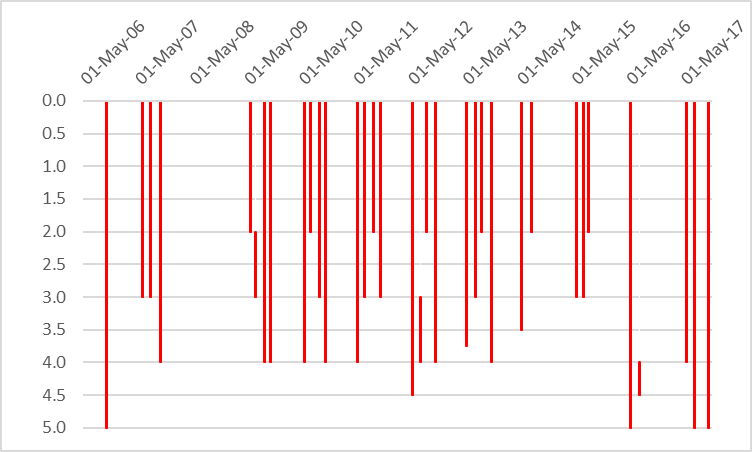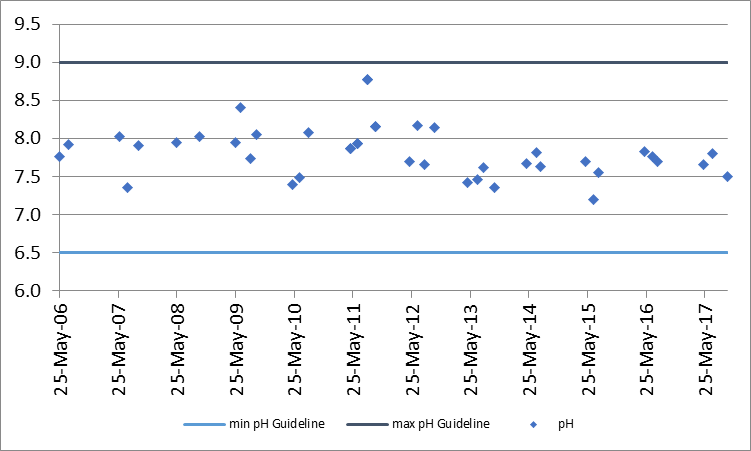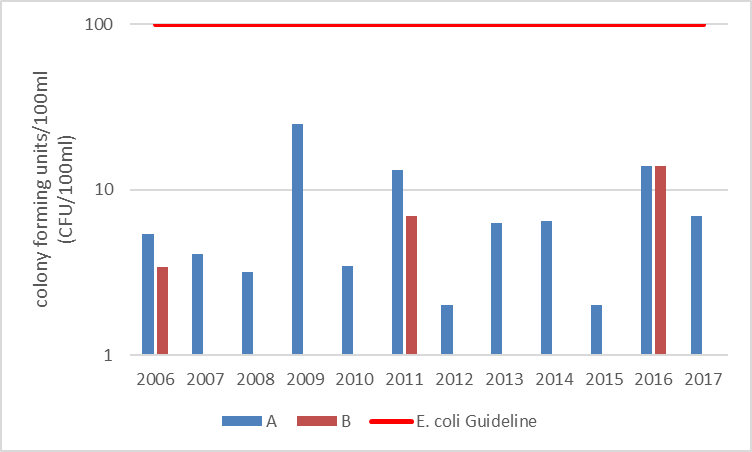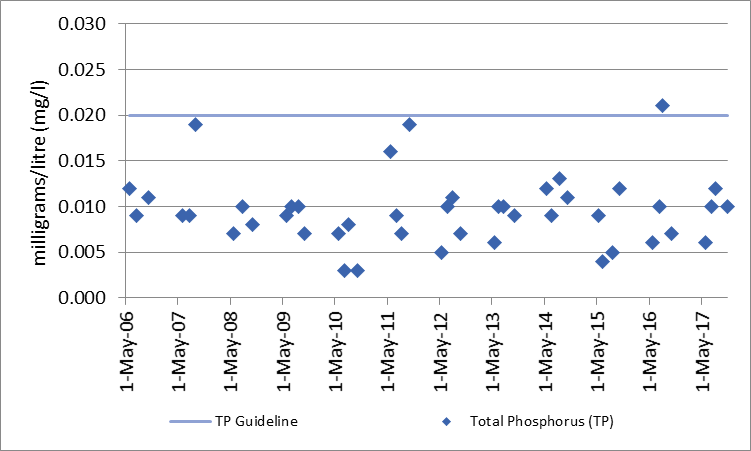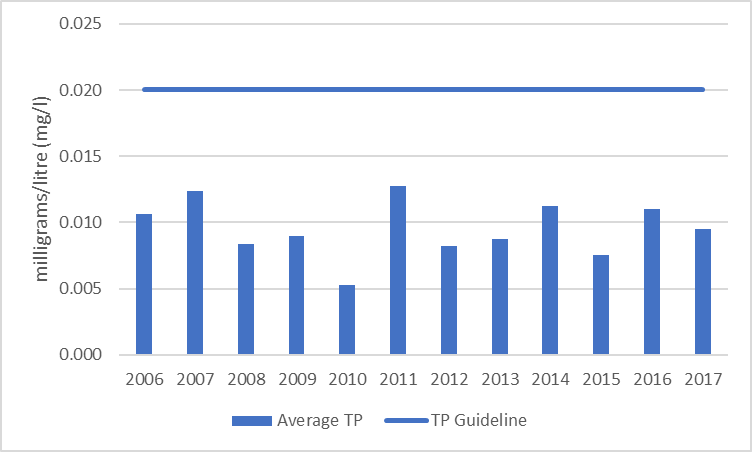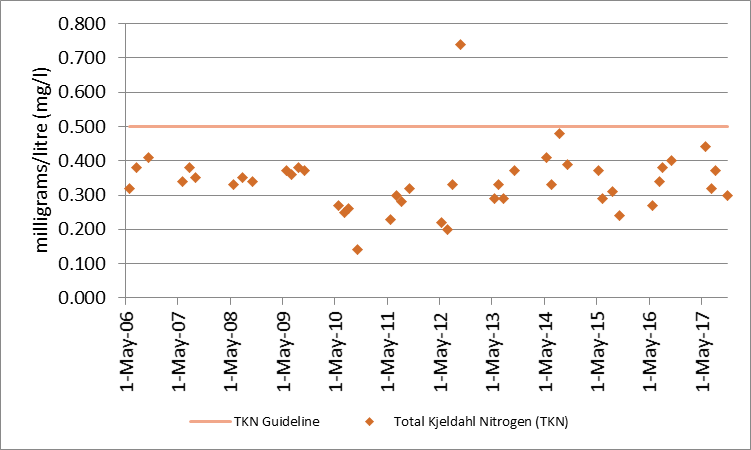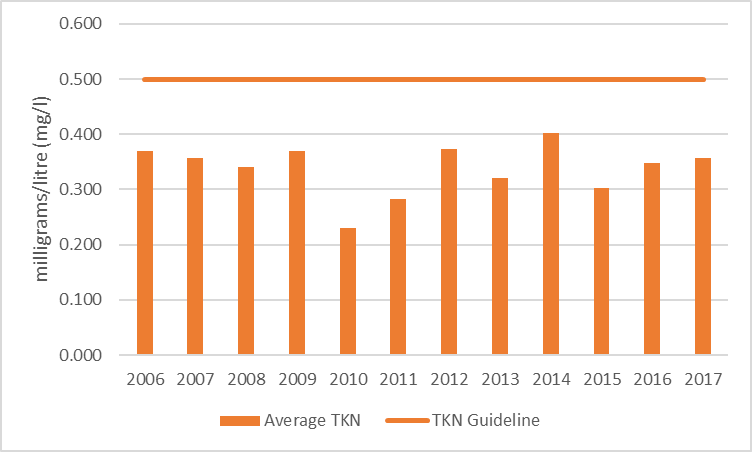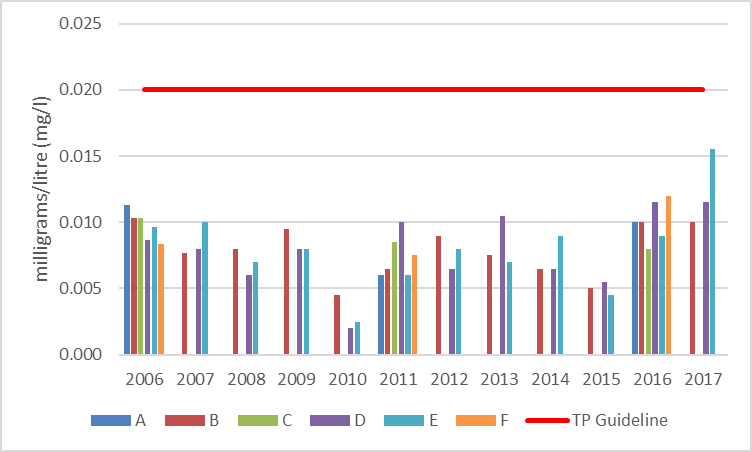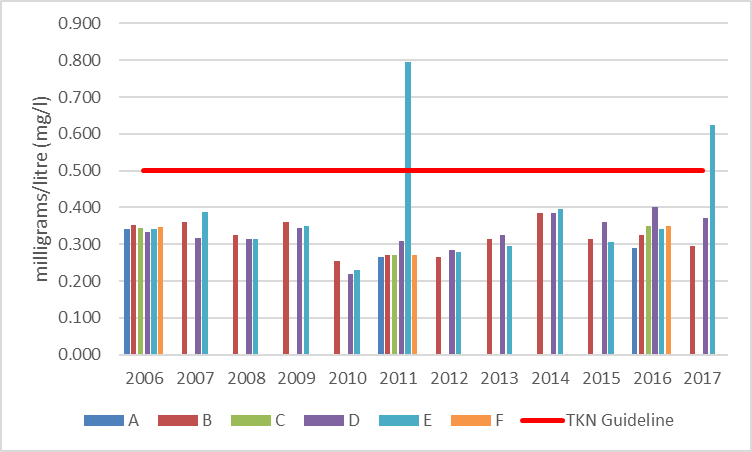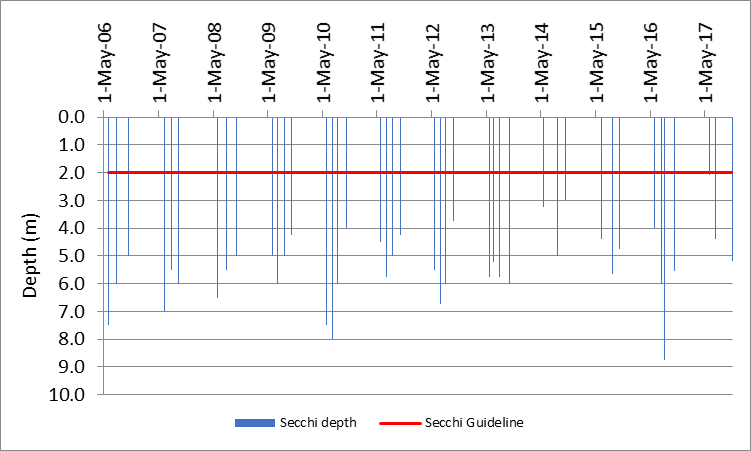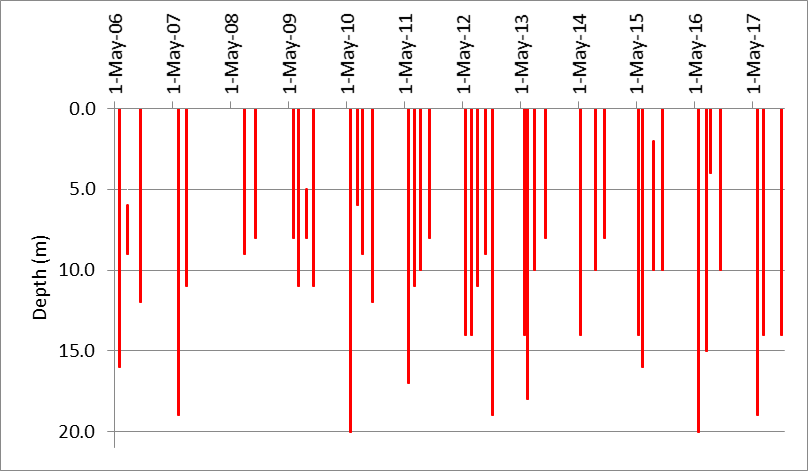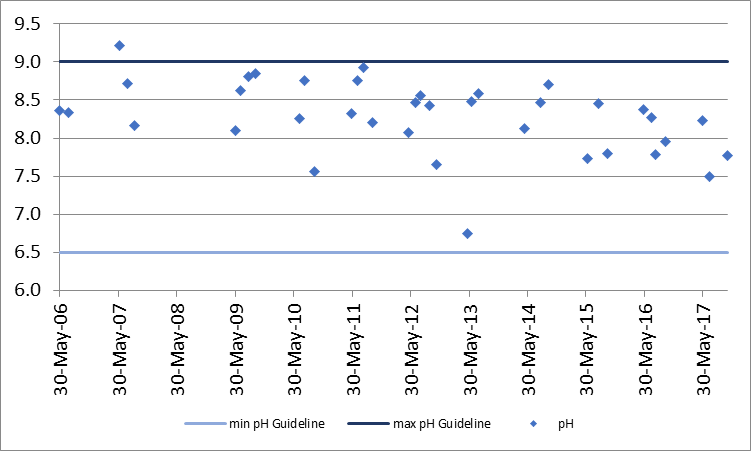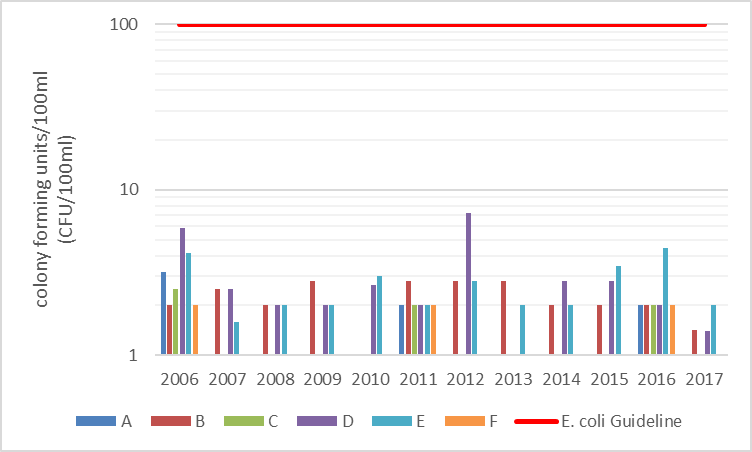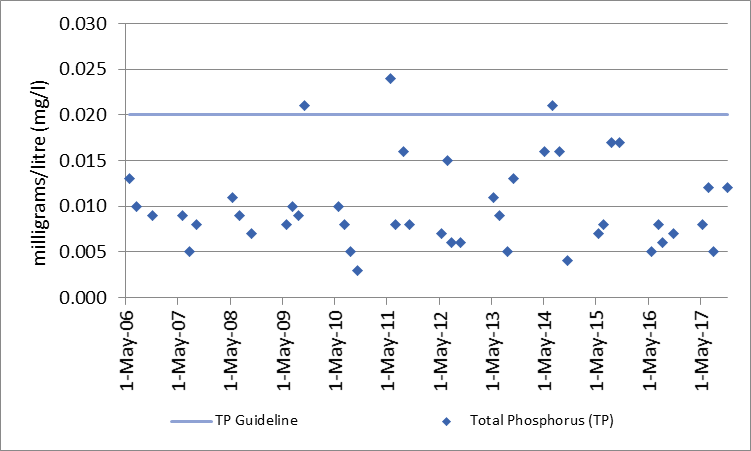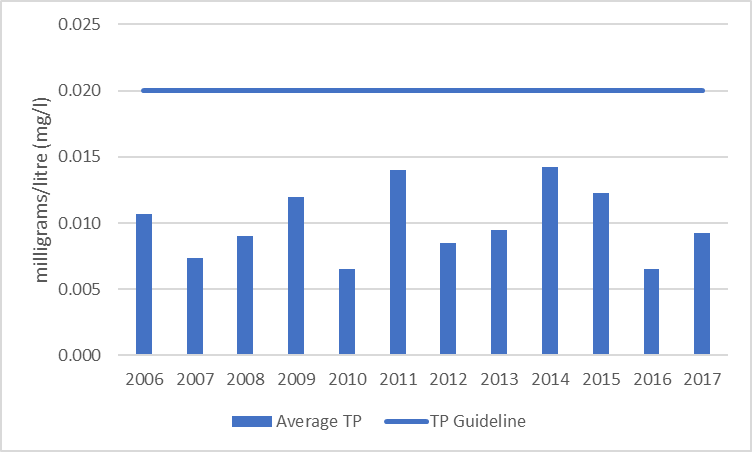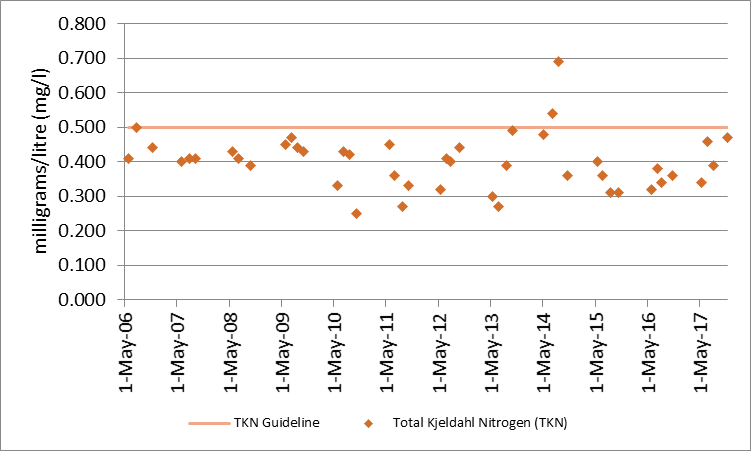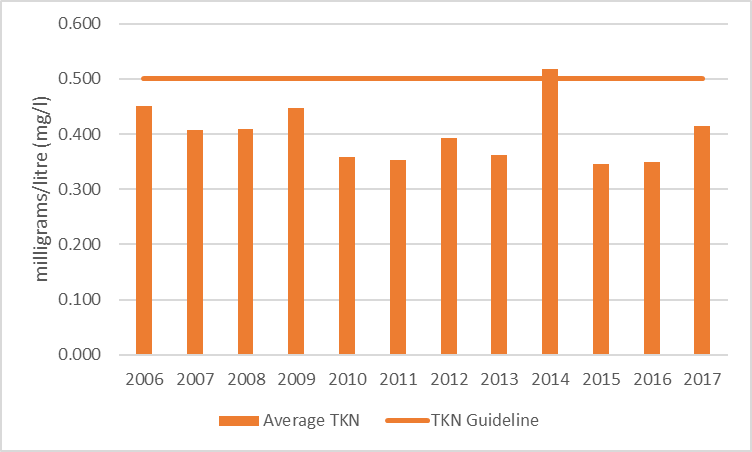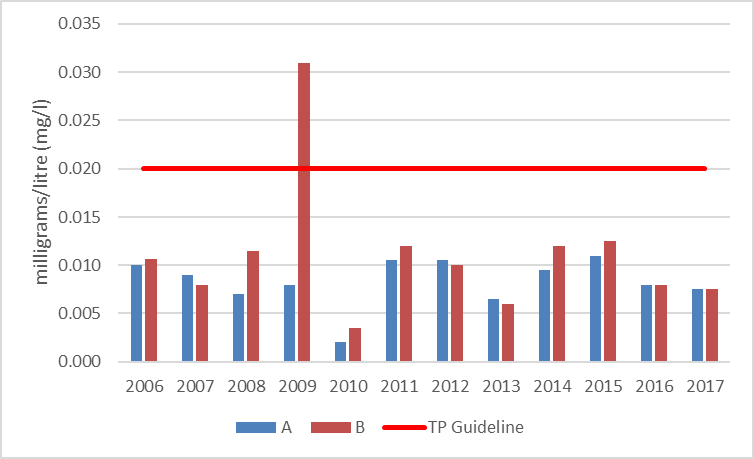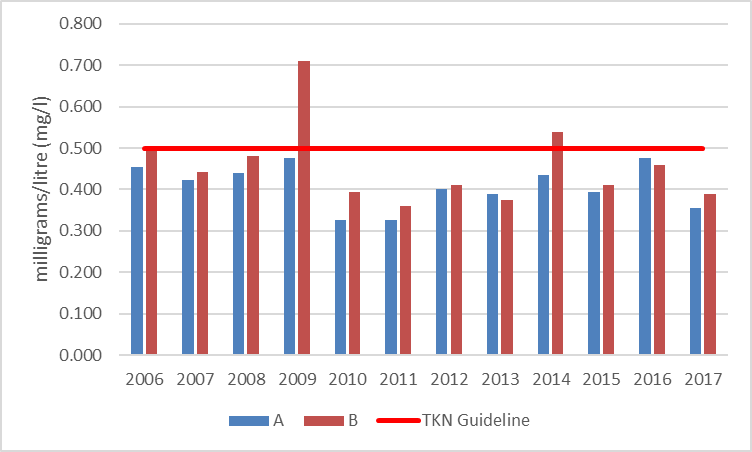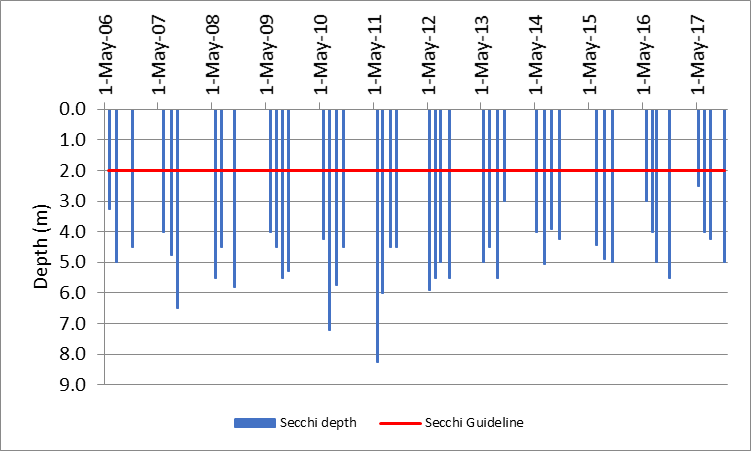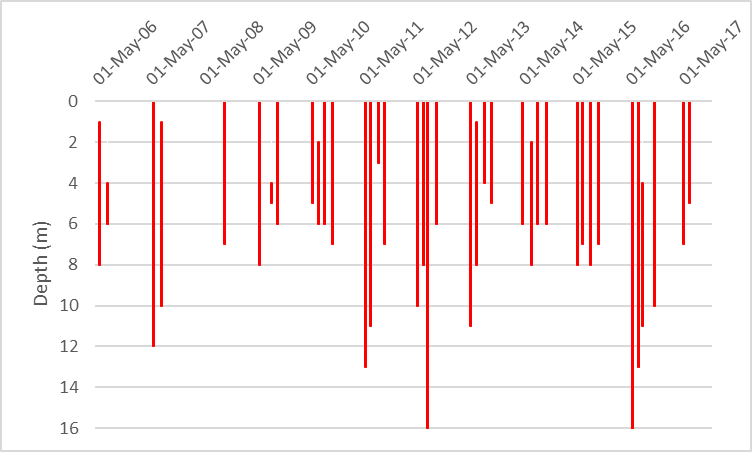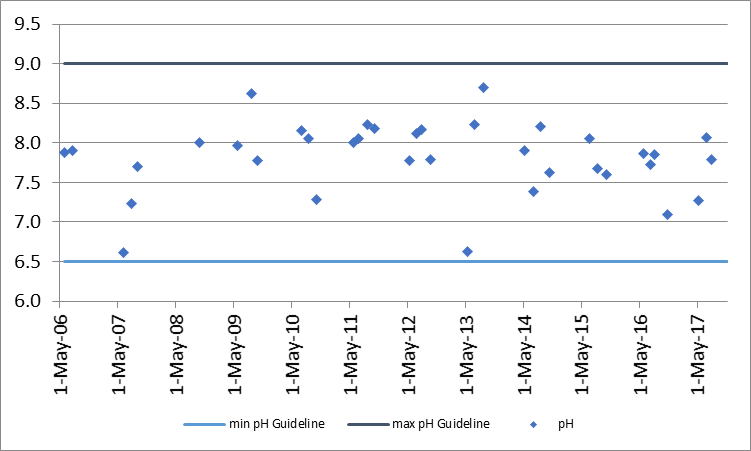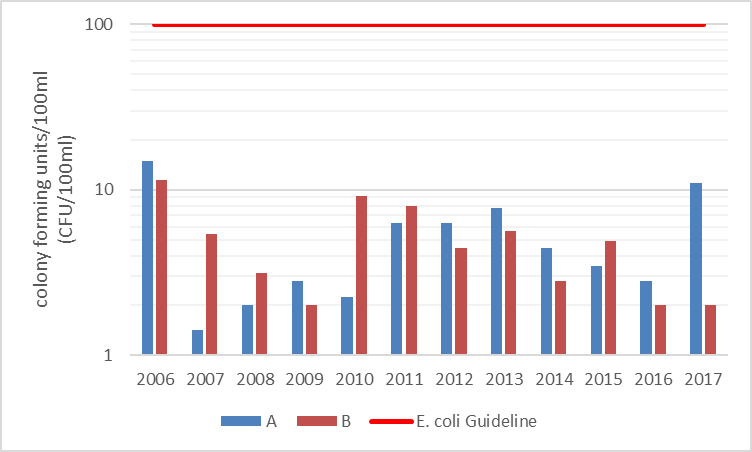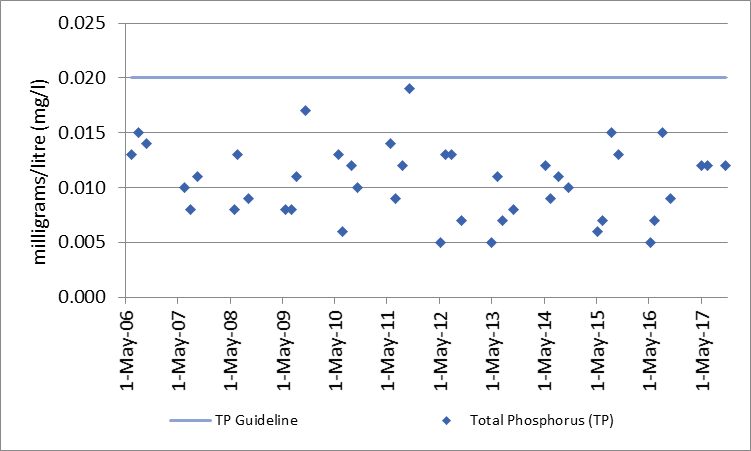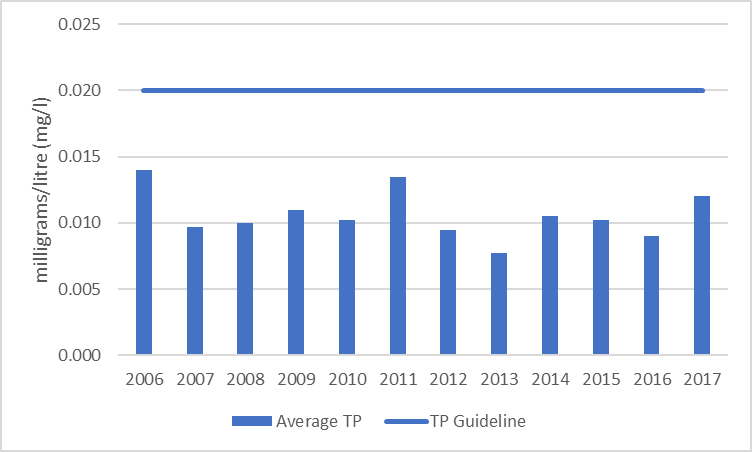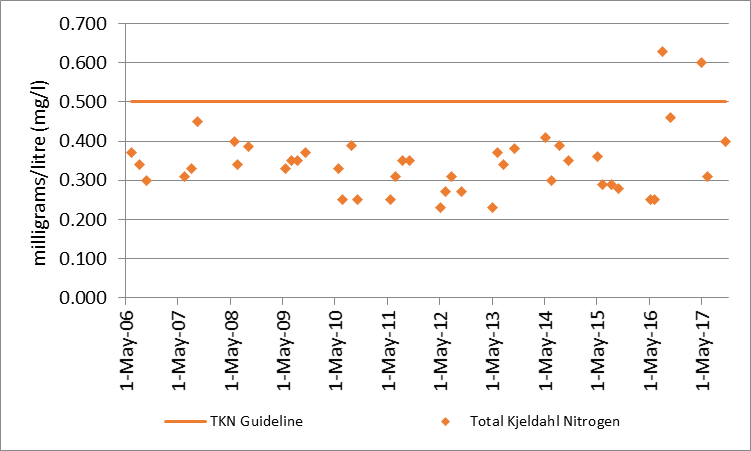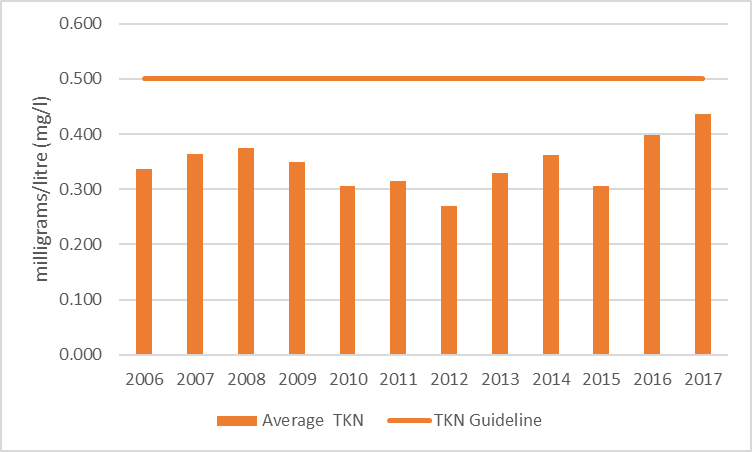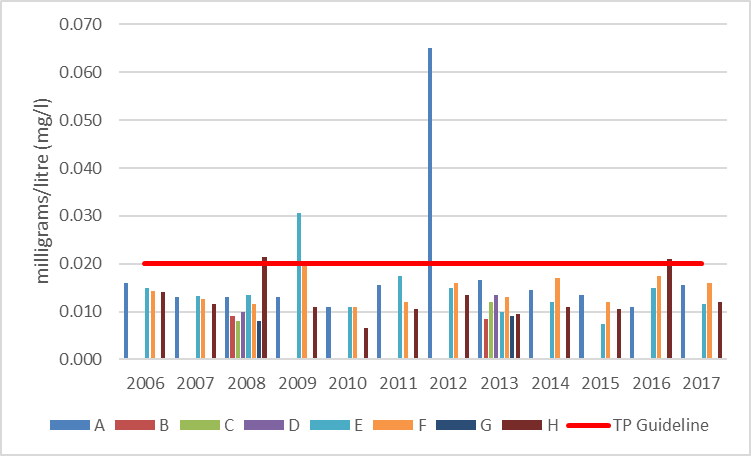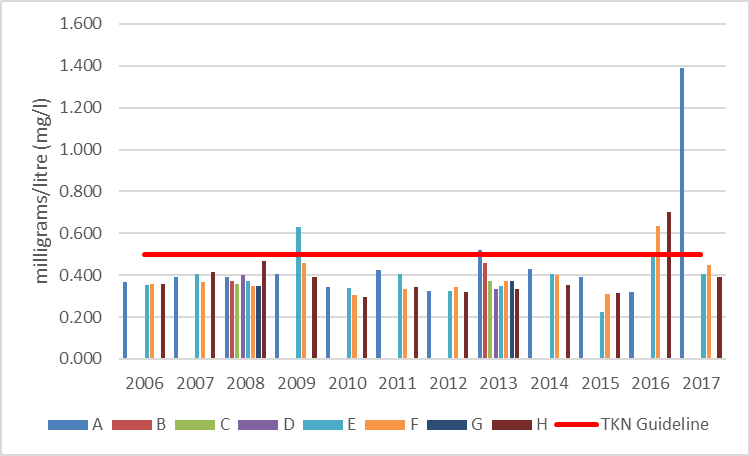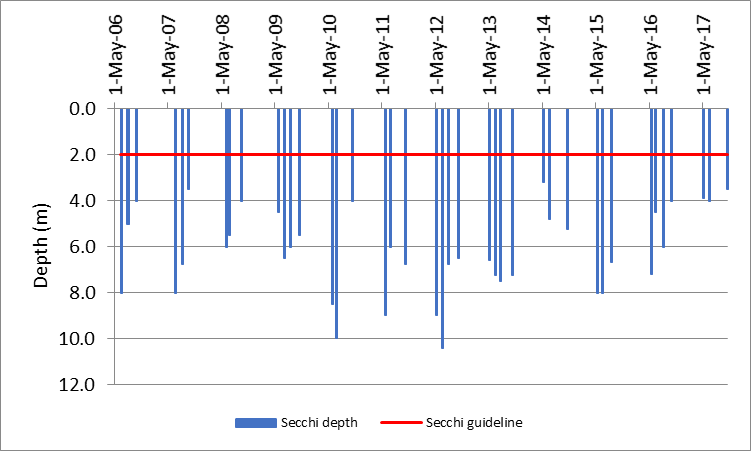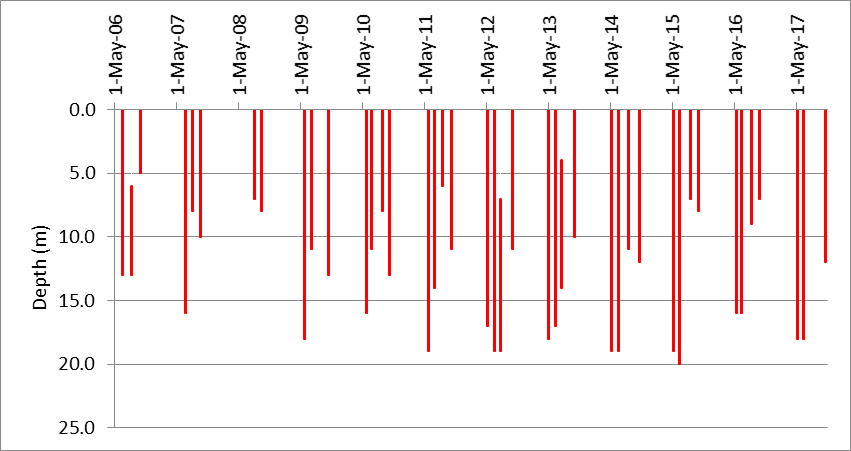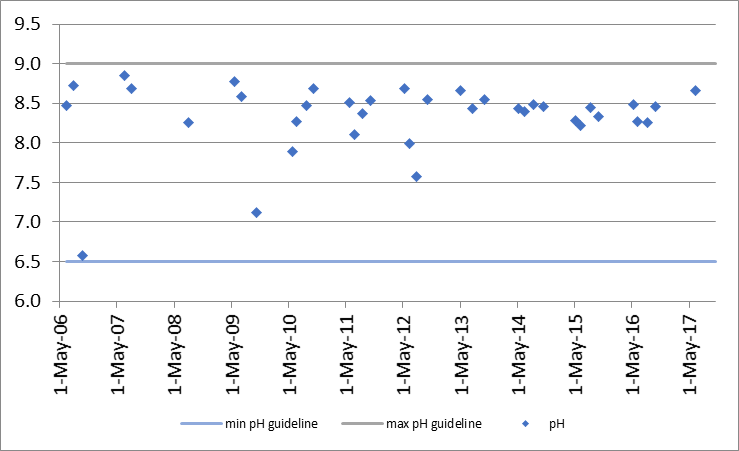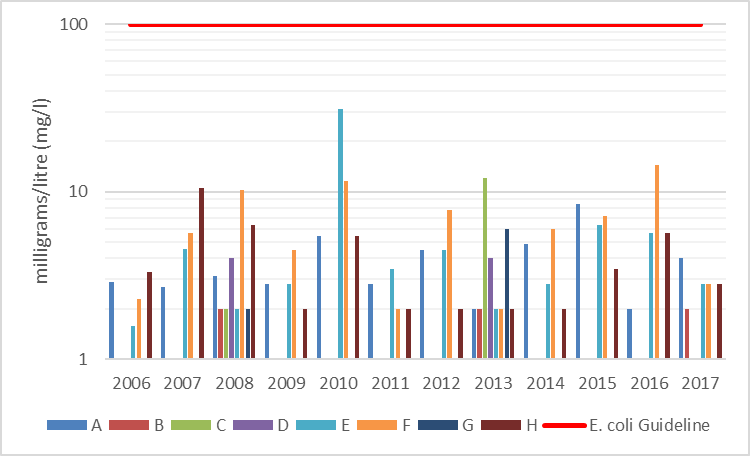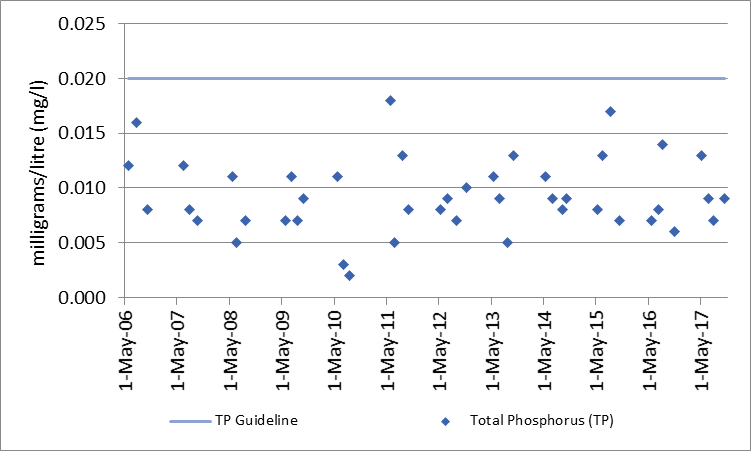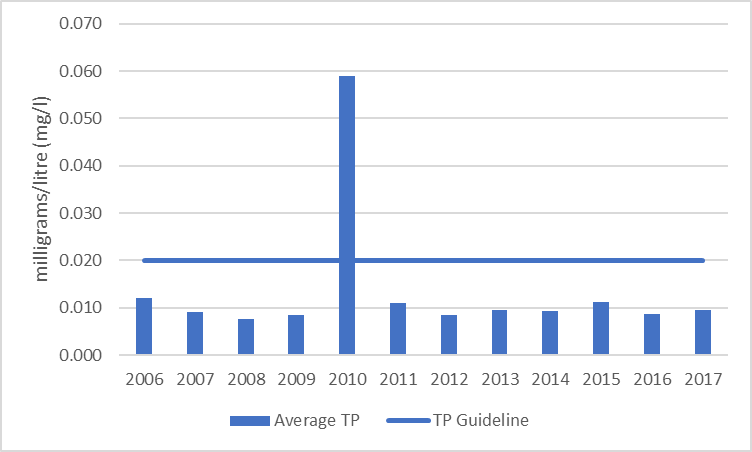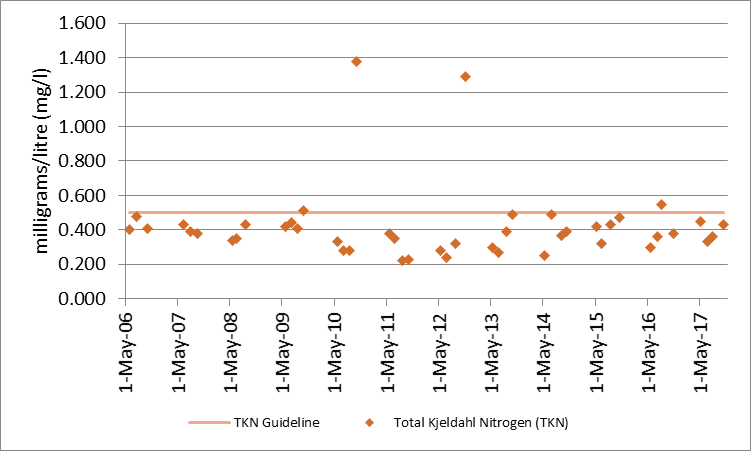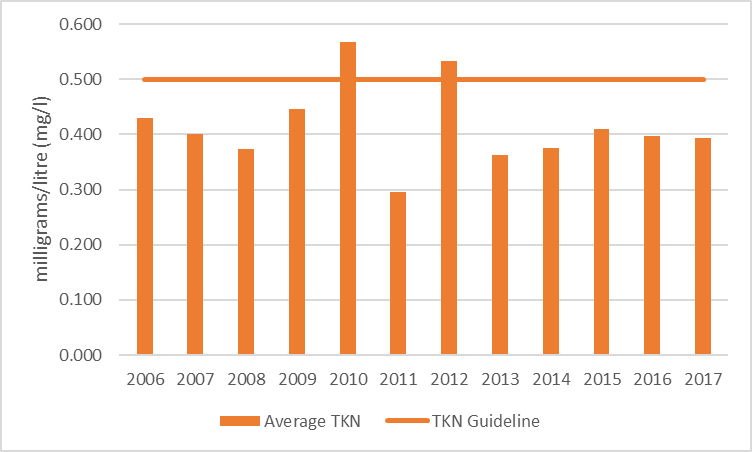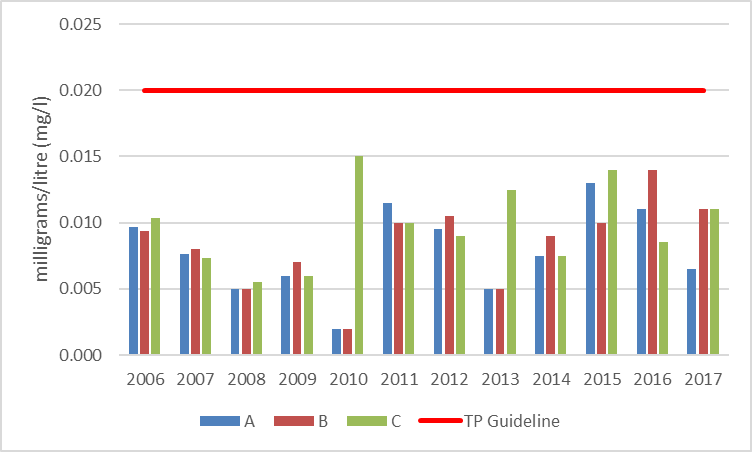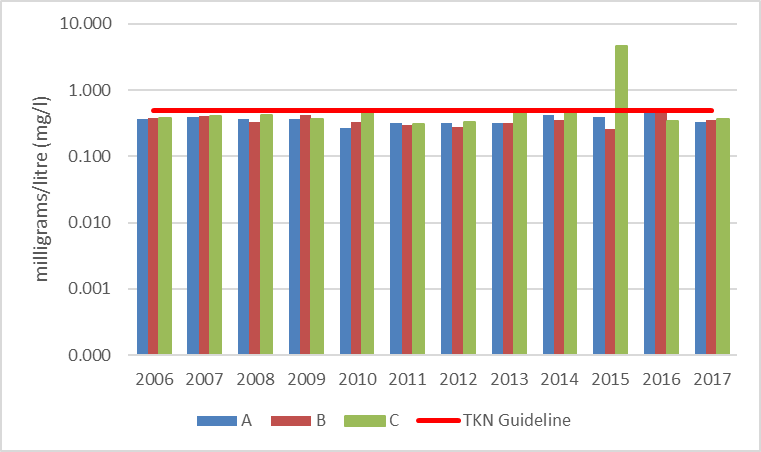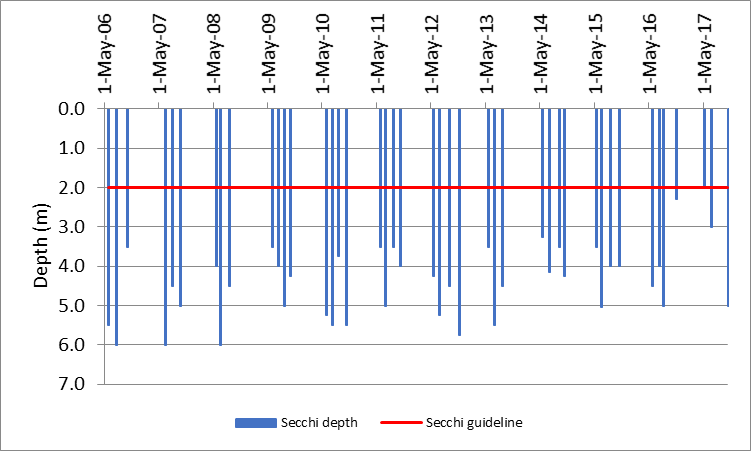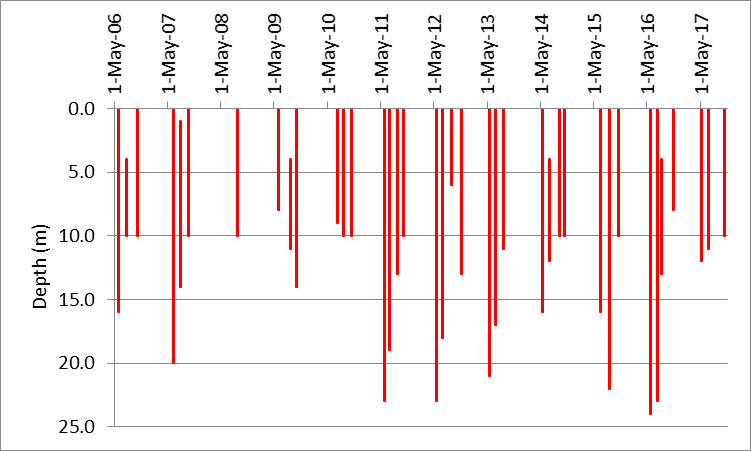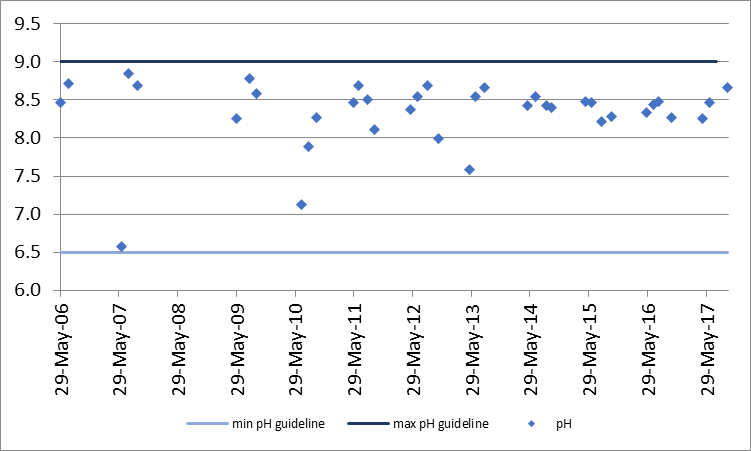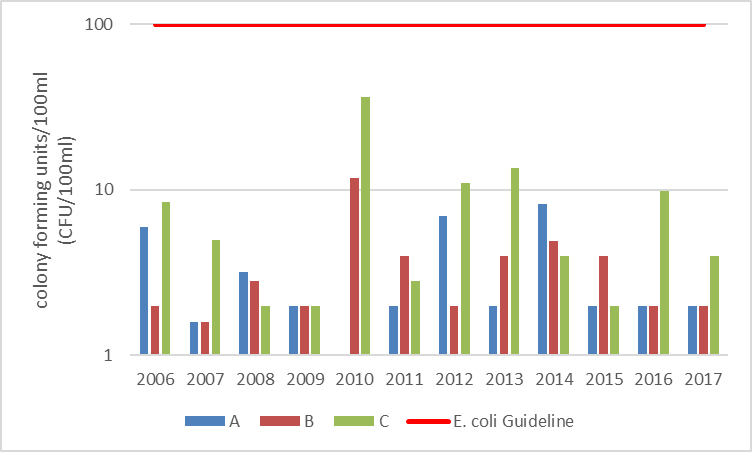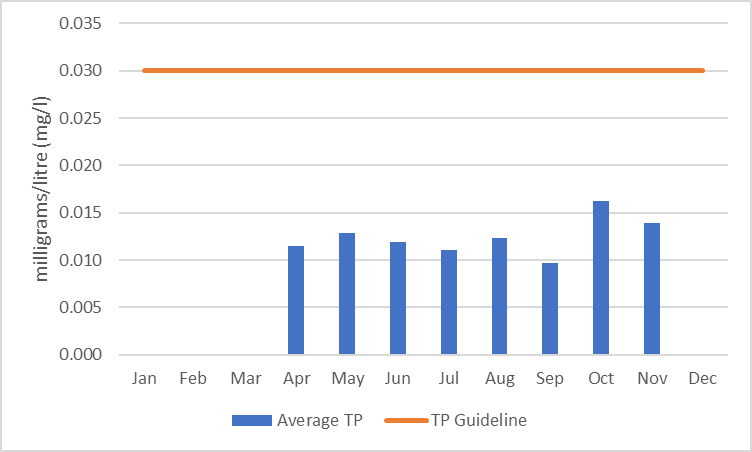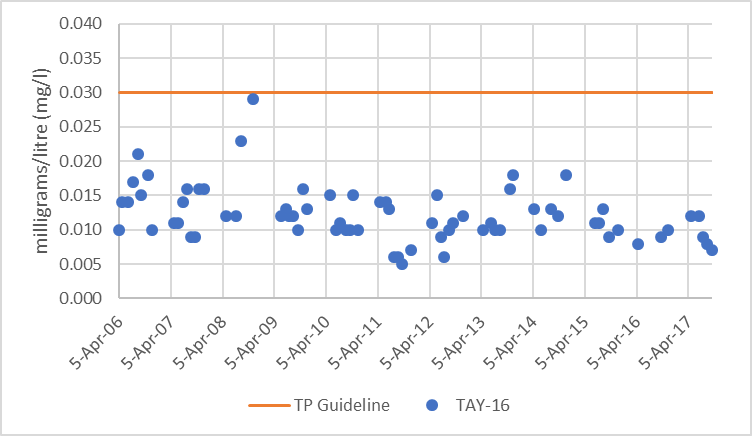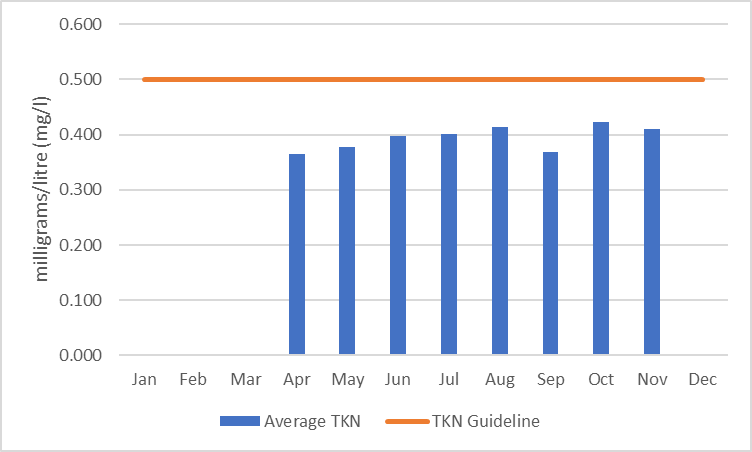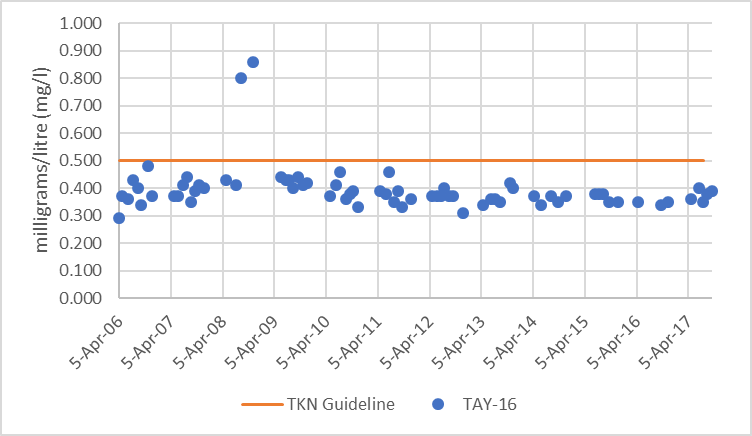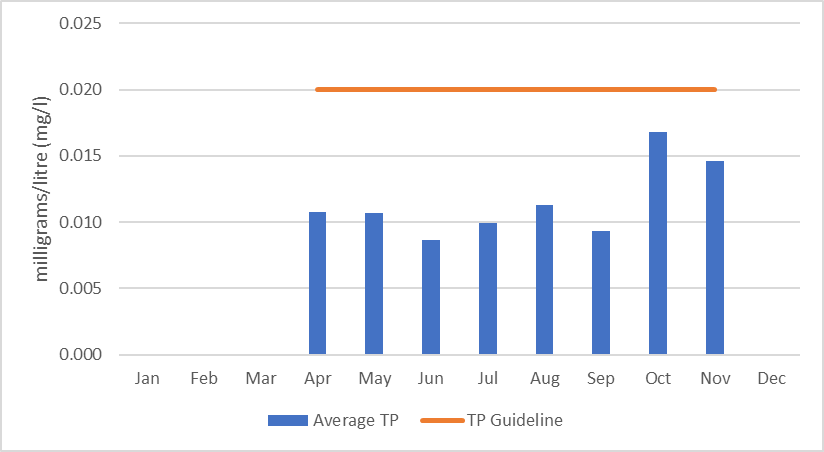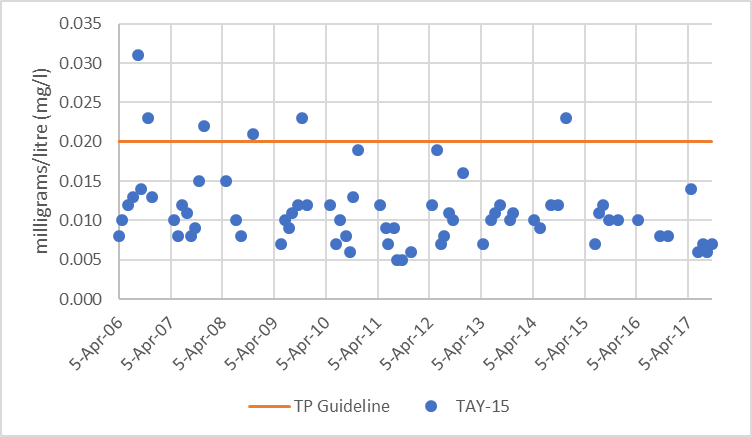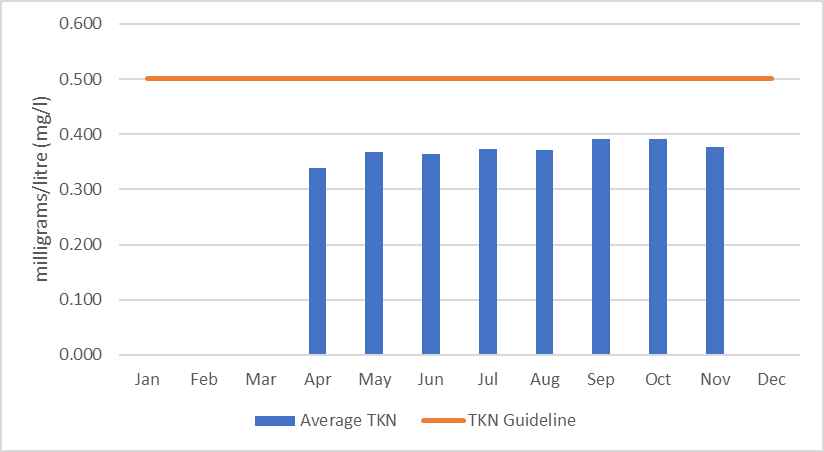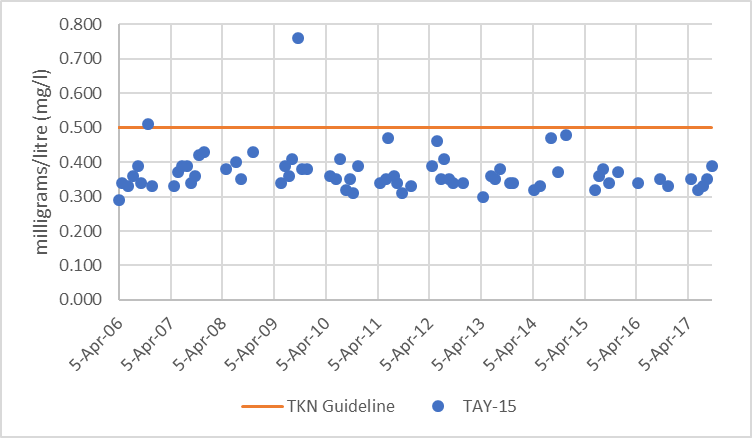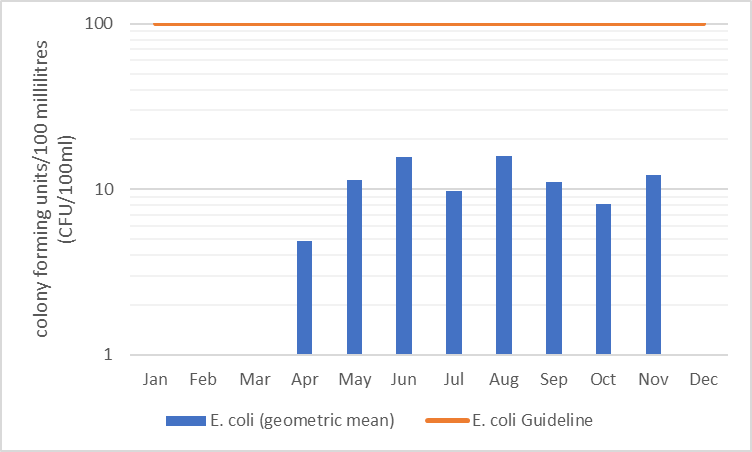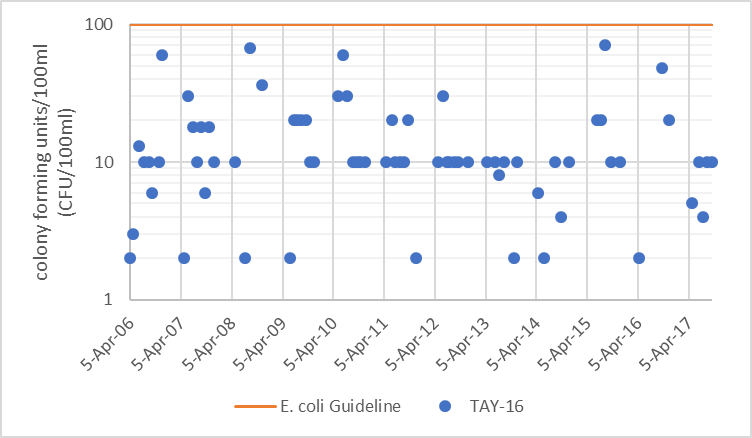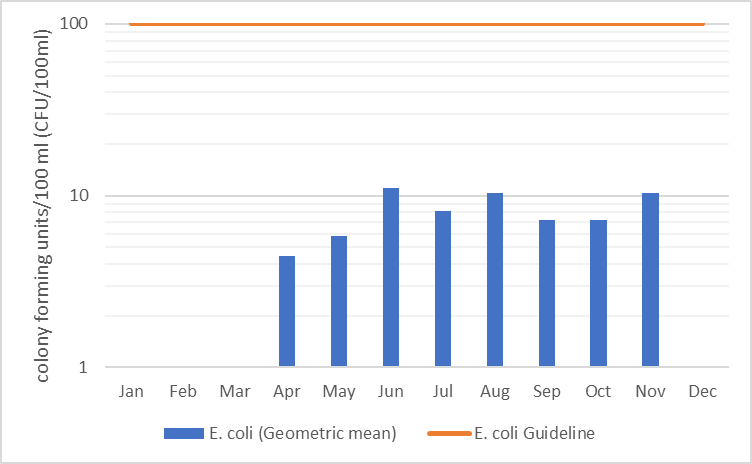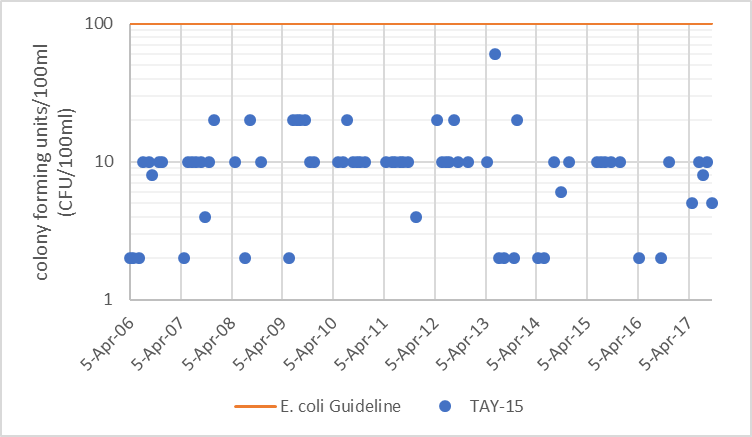2.0 Christie Lake Catchment: Water Quality Conditions
Surface water quality conditions in the Christie Lake catchment are monitored by the Rideau Valley Conservation Authority’s (RVCA) Watershed Watch Program and Baseline Water Quality Monitoring Program. Watershed Watch monitors watershed lakes to assess nutrient concentrations, water clarity, dissolved oxygen availability and pH. The baseline water quality program focuses on streams; data is collected for 22 parameters including nutrients (total phosphorus, total Kjeldahl nitrogen and ammonia), E. coli, metals (like aluminum and copper) and additional chemical/physical parameters (such as alkalinity, chlorides, pH and total suspended solids). Figure 2 shows the locations of monitoring sites in the catchment.
Water Quality Rating in the Christie Lake Catchment
The water quality ratings scored high across this catchment and range from "Fair to Very Good" (Table 1); with a rating of "Fair” in Little Silver Lake, "Fair to Good" in Farren and Rainbow Lakes, "Fair to Very Good" in O’Brien Lake and “Good to Very Good” in Christie and Davern Lakes. At the two monitoring sites on the Tay River (TAY-16 and TAY-15), water quality rated as “Very Good” and “Good to Very Good” respectively.
All ratings are determined using by the Canadian Council of Ministers of the Environment (CCME) Water Quality Index. A "Fair" rating indicates that water quality is usually protected but is occasionally threatened or impaired; conditions sometimes depart from natural or desirable levels. A rating of "Good" indicates that only a minor degree of threat or impairment is observed and conditions rarely depart from natural or desirable levels. “Very Good indicates water quality is protected with a virtual absence of threat or impairment; conditions are very close to natural or pristine levels.”
Each water quality parameter is evaluated against established guidelines to determine water quality conditions. Those parameters that frequently exceed guidelines are presented below. Data has been analyzed over the 2006-2017 period for general trends and conditions. Table 1 shows the overall rating for the monitored surface water quality sites within the catchment and Table 2 outlines the Water Quality Index (WQI) scores and their corresponding ratings.
| Site | Location | 2006-2008 | 2009-2011 | 2012-2014 | 2015-2017 |
|---|---|---|---|---|---|
| DP1 | Christie Lake | Good (88) | Very Good (100) | Very Good (100) | Good (88) |
| DP1 | Davern Lake | Very Good (100) | Fair (75) | Good (88) | Good (88) |
| DP1 | Farren Lake | Fair (77) | Very Good (100) | Very Good (100) | Good (88) |
| DP1/DP3 | Little Silver Lake | Fair (76) | Fair (65) | Fair (76) | Fair (77) |
| DP1 | O'Brien Lake | Very Good (100) | Fair (76) | Fair (65) | Very Good (100) |
| DP1 | Rainbow Lake | Fair (75) | Fair (76) | Fair (75) | Good (85) |
| TAY-16 | Tay River at Bolingbroke | Good (91) | Very Good (97) | Very Good (100) | Very Good (100) |
| TAY-15 | Tay R. at Christie L. outlet | Good (91) | Good (94) | Very Good (100) | Very Good (100) |
| Rating | Index Score |
|---|---|
| Very Good (Excellent) | 95-100 |
| Good | 80-94 |
| Fair | 65-79 |
| Poor (Marginal) | 45-64 |
| Very Poor (Poor) | 0-44 |
2.1 Little Silver Lake Water Quality
Surface water quality conditions in Little Silver Lake have been monitored by RVCA’s Watershed Watch Program since 2006. Data from the deep point sites (DP1 and DP3) have been used to calculate the WQI rating for Little Silver Lake, which averaged “Fair” over the 2006-2017 period (Table 1). Moderate nutrient concentrations, good oxygen availability and clear water all influenced this rating. The following discussion explains how each of the monitored water quality parameters contributes to the lake’s water quality.
This report also considers data from seven additional shoreline sites that are monitored around the lake. These sites have not been included in the calculation of the CCME WQI rating, as they are not monitored with the same frequency as the deep point site. However, they do provide important information on water quality conditions in the near shore areas. For locations of shoreline sites (A-H), please see Figure 2.
2.1.1 Little Silver Lake Nutrients
Total phosphorus (TP) is used as a primary indicator of excessive nutrient loading and contributes to abundant aquatic vegetation growth and depleted dissolved oxygen levels. The Provincial Water Quality Objective (PWQO) is used as the TP Guideline and states that in lakes, concentrations greater than 0.020 mg/l indicate an excessive amount of TP within the water column.
Total Kjeldahl nitrogen (TKN) is used as a secondary indicator of nutrient loading. RVCA uses a guideline of 0.500 mg/l to assess TKN[1] within surface waters.
Nutrients at the Little Silver Lake Deep Points
TP and TKN sampling results collected by the RVCA are presented in Figures 3 to 6. Some variability has occurred in the sampled TP concentrations at this site (Figures 3 and 4), and a decreasing trend[2] was observed in the 2006-2017 data set. Eighty-seven percent of samples analyzed for TP were less than the TP guideline and the average concentration was 0.014 mg/l (Table 3). TKN concentration also showed variability though no significant change was observed (Figures 5 and 6). Eighty-nine percent of reported results were below the TKN guideline and the average TKN concentration was 0.379 mg/l (Table 3).
| Total Phosphorous 2006-2017 | |||
|---|---|---|---|
| Site | Average (mg/l) | Below Guideline | No. Samples |
| DP1/DP3 | 0.014 | 87% | 87 |
| Total Kjeldahl Nitrogen 2006-2017 | |||
| Site | Average (mg/l) | Below Guideline | No. Samples |
| DP1/DP3 | 0.379 | 89% | 88 |
Overall, the data presented indicates that nutrient concentration may be considered low with occasional exceedances in the mid-lake, deep water sites on Little Silver Lake.
Nutrients around Little Silver Lake
The average nutrient concentrations at monitored shoreline sites around the lake vary from year to year (Figures 7 and 8). Please note that in the 2006-2017 monitoring period sites A, E and F were monitored yearly; while sites B, C, D and G were only sampled in 2006, 2011 and 2016.
Average total phosphorous concentrations are below the TP guideline at all sites (Figure 7), as are the average total Kjeldahl nitrogen concentrations for the TKN guideline at all sites (Figure 8).
Summary of Little Silver Lake Nutrients
Little Silver Lake nutrient concentrations are generally below the guidelines, with few exceedances. It is possible that occasional problems with nutrient enrichment (i.e. algal blooms or excessive plant growth) may be observed in shallow, sheltered bays.
Efforts such as the diversion of runoff and enhanced shoreline buffers are important to continue to protect and enhance water quality, and reduce future nutrient increases. Nutrient exceedances may be partially attributed to the natural aging of a lake and basin characteristics. All residents can help minimize their impact on the lake by reducing nutrient inputs through practices such as proper maintenance of septic systems, keeping shorelines natural and using phosphate free soaps and detergents. Promotion of sound stewardship and protection around lake is important to maintain and protect water quality conditions into the future.
2.1.2 Little Silver Lake Water Clarity
Water clarity is measured using a Secchi disk during each deep point sample. Table 4 summarizes the recorded depths with an average depth of 4.7 m and shows that most (96% of) readings have exceeded the minimum PWQO of 2 m indicating that algae in the water column are not at excessive levels (good water clarity). Less than 2 m will indicate overproduction in a lake or significant inputs to the water column that are limiting light availability. Figure 9 shows that no individual reading has been below the guideline and measured depths range from 2.5 m to 8.0 m. A decreasing trend was observed within the 2006-2017 data set, indicating that Secchi depths have been reduced over this period.
| Secchi 2006-2017 | |||
|---|---|---|---|
| Site | Average (m) | Above Guideline | No. Samples |
| DP1/DP3 | 4.7 | 96% | 83 |
Summary of Little Silver Lake Water Clarity
Waters in Little Silver Lake are generally clear and sufficient sunlight is able to penetrate the water column to support aquatic life and provide sufficient visibility for safe recreational use (boating, swimming).
2.1.3 Little Silver Lake Fish Habitat
Two other factors, dissolved oxygen/temperature and pH were also assessed to provide an overall sense of the health of Little Silver Lake from a fish habitat perspective.
2.1.3.1 Little Silver Lake Dissolved Oxygen and Temperature
The red bars in Figure 10 show the depths where suitable conditions exist for warm water fish species (temperature less than 25°C and dissolved oxygen greater than 4 mg/l) at the deep point site. The vertical axis represents the total lake depth. Suitable conditions typically decline throughout the summer to about 6m of the water column. In late 2016, habitat conditions were notably low due to the warming of the water column. Overall, no significant change was noted in conditions through the 2006-2017 period.
2.1.3.2 Little Silver Lake pH
pH is a basic water quality parameter used to assess the acidity of water, an important factor for aquatic life. Figure 11 shows the monitored pH values over the 2006-2017 period.
The majority of samples (99%) for both time periods were within guidelines established by the Canadian Council of Minister's of the Environment which state that pH should be between 6.5 and 9 to protect aquatic life (Table 5, Figure 11). Surface water’s that are found to be more alkaline (higher pH) are common in many regions of the Tay River subwatershed and can generally be attributed to the geology rather than anthropogenic activities. Biological activities such as increased photosynthesis from algal blooms and plant growth may also influence pH.
| pH 2006-2017 | |||
|---|---|---|---|
| Site | Average (mg/l) | Within Guideline | No. Samples |
| DP1/DP3 | 7.9 | 99% | 76 |
Summary of Water Quality for Fish Habitat in Little Silver Lake
Overall the water chemistry data at the deep point describes suitable habitat conditions for fish species such as bass, walleye and pike. pH conditions are within the range recommended for the protection of aquatic life. Overall, the data indicates a healthy environment for aquatic species.
2.1.4 Little Silver Lake E. Coli
E. coli is sampled at monitored shoreline sites twice each sampling season. E. coli data was not used in the calculations of the WQI rating for the lake due to differences in sampling frequency and site locations. E. coli data has been summarized in Table 6.
Throughout the 2006-2017 period 100 percent of samples collected by RVCA were below the E. coli guideline of 100 colony forming units (CFU) per 100 ml set by the PWQO; across the lake the count at the geometric mean was 3 CFU/100ml (Table 6). This provides support that there is little indication of bacterial contamination around the lake. Figure 12 show the distribution of counts across all shoreline sites. All sites fell well below the guideline of 100 CFU/100ml.
| E. coli 2006-2017 | |||
|---|---|---|---|
| Site | Geometric mean (CFU/100ml) | Below Guideline | No. Samples |
| A-G | 3 | 100% | 103 |
Summary of Little Silver Lake Bacterial Contamination
The results presented above indicate that bacterial contamination is not a significant concern in Little Silver Lake and the water should be safe for recreational use such as swimming and boating.
2.2 Rainbow Lake Water Quality
Surface water quality conditions in Rainbow have been monitored by RVCA’s Watershed Watch Program since 2006. Data from the deep point sites (DP1) have been used to calculate the WQI rating for Rainbow Lake, which averaged “Fair to Good” over the 2006-2017 period (Table 1). Moderate nutrient concentrations, good oxygen availability and clear water all influenced this rating. The following discussion explains how each of the monitored water quality parameters contributes to the lake’s water quality.
This report also considers data from two additional shoreline sites that are monitored around the lake. These sites have not been included in the calculation of the CCME WQI rating, as they are not monitored with the same frequency as the deep point site. However, they do provide important information on water quality conditions in the near shore areas. For locations of shoreline sites (A and B), please see Figure 2.
2.2.1 Rainbow Lake Nutrients
Total phosphorus (TP) is used as a primary indicator of excessive nutrient loading and contributes to abundant aquatic vegetation growth and depleted dissolved oxygen levels. The Provincial Water Quality Objective (PWQO) is used as the TP Guideline and states that in lakes, concentrations greater than 0.020 mg/l indicate an excessive amount of TP within the water column.
Total Kjeldahl nitrogen (TKN) is used as a secondary indicator of nutrient loading. RVCA uses a guideline of 0.500 mg/l to assess TKN[1] within surface waters.
Nutrients at the Rainbow Lake Deep Point
TP and TKN sampling results collected by the RVCA are presented in Figures 13 to 16. Fluctuations in TP concentrations are common, with the majority of results below the guideline (Figures 13 and 14); a decreasing trend[2] in TP concentrations was observed in the 2006-2017 data set. A similar decline was also observed in Little Silver Lake which receives Rainbow Lake's outflow. Eighty-two percent of samples analyzed for TP were less than the TP guideline and the average concentration was 0.015 mg/l (Table 7). TKN concentrations also showed variability and no significant change was observed (Figures 15 and 16). Fifty-one percent of reported results were below the TKN guideline and the average TKN concentration was 0.488 mg/l (Table 7).
| Total Phosphorous 2006-2017 | |||
|---|---|---|---|
| Site | Average (mg/l) | Below Guideline | No. Samples |
| DP1 | 0.015 | 82% | 49 |
| Total Kjeldahl Nitrogen 2006-2017 | |||
| Site | Average (mg/l) | Below Guideline | No. Samples |
| DP1 | 0.488 | 51% | 49 |
Overall, the data presented indicates that nutrient concentrations may be considered low with occasional exceedances in the mid-lake, deep water sites on Rainbow Lake. Elevated TKN concentrations can likely be attributed to the influence of surrounding wetlands that drain into the lake, as well as influence of nutrient rich sediments in this very shallow waterbody.
Nutrients around Rainbow Lake
The average nutrient concentrations at monitored shoreline sites around the lake have varied from year to year (Figures 17 and 18). Please note that in the 2006-2017 monitoring period, only site A was monitored yearly; site B was sampled in 2006, 2011, 2016 and 2017.
Average total phosphorous concentrations are below the TP guideline at site B during the monitored years (Figure 17). Site A had elevated results in 2006 and 2011, however all subsequent yearly results have been below the guideline. Average TKN concentrations have exceeded or approach the guideline frequently at site A, while results at site B are below the guideline for each year of data (Figure 18).
Summary of Rainbow Lake Nutrients
Rainbow Lake nutrient data shows that elevated levels of TKN are common in this waterbody. As previously noted Rainbow Lake is a shallow water body and these elevated concentrations can likely be attributed to wetland characteristics and the influence of nutrient rich sediments on the surface water. It is possible that occasional problems with nutrient enrichment (i.e. algal blooms or excessive plant growth) may be observed in shallow, sheltered bays.
Efforts such as the diversion of runoff and enhanced shoreline buffers are important to continue to protect and enhance water quality, and reduce future nutrient increases. Nutrient exceedances may be partially attributed to the natural aging of a lake and basin characteristics. All residents can help minimize their impact on the lake by reducing nutrient inputs through practices such as proper maintenance of septic systems, keeping shorelines natural and using phosphate free soaps and detergents. Promotion of sound stewardship and protection around lake is important to maintain and protect water quality conditions into the future.
2.2.2 Rainbow Lake Water Clarity
Water clarity is measured using a Secchi disk during each deep point sample. Table 8 summarizes the recorded depths with an average depth of 3.3 m and shows that all readings have exceeded the minimum PWQO of 2 m indicating that algae in the water column is not at excessive levels (good water clarity). Less than 2 m will indicate overproduction in a lake or significant inputs to the water column that are limiting light availability. Figure 19 shows that no individual reading has been below the guideline and measured depths range from 2.1 m to 5.0 m. No significant change was noted in Secchi depth over the 2006-2017 period.
| Secchi 2006-2017 | |||
|---|---|---|---|
| Site | Average (m) | Above Guideline | No. Samples |
| DP1 | 3.3 | 100% | 44 |
Summary of Rainbow Lake Water Clarity
Waters in Rainbow Lake are clear and sufficient sunlight is able to penetrate the water column to support aquatic life and provide sufficient visibility for safe recreational use (boating, swimming).
2.2.3 Rainbow Lake Fish Habitat
Two other factors, dissolved oxygen/temperature and pH were also assessed to provide an overall sense of the health of Rainbow Lake from a fish habitat perspective.
2.2.3.1 Rainbow Lake Dissolved Oxygen and Temperature
The red bars in Figure 20 show the depths where suitable conditions exist for warm water fish species (temperature less than 25°C and dissolved oxygen greater than 4 mg/l) at the deep point site. The vertical axis represents the total lake depth at each site where the profile is taken. Suitable conditions typically decline throughout the summer to about 2m-3.5m of the water column. In late 2016, habitat conditions were notably low due to the warming of the water column. Overall, no significant change was noted in conditions through the 2006-2017 period.
2.2.3.2 Rainbow Lake pH
pH is a basic water quality parameter used to assess the acidity of water, an important factor for aquatic life. Figure 21 shows monitored pH values over the 2006-2017 period.
All samples for pH are within guidelines established by the Canadian Council of Minister's of the Environment which state that pH should be between 6.5 and 9 to protect aquatic life (Table 9, Figure 21). Surface water’s that are found to be more alkaline (higher pH) are common in many regions of the Tay River subwatershed and can generally be attributed to the geology rather than anthropogenic activities. Biological activities such as increased photosynthesis from algal blooms and plant growth may also influence pH.
| pH 2006-2017 | |||
|---|---|---|---|
| Site | Average (mg/l) | Within Guideline | No. Samples |
| DP1 | 7.8 | 100% | 42 |
Summary of Water Quality for Fish Habitat in Rainbow Lake
Overall the water chemistry data at the deep point describes suitable habitat conditions for warm water fish species, though these can become limited during warm periods. pH conditions are within the range recommended for the protection of aquatic life. Overall, the data indicates a healthy environment for aquatic species.
2.2.4 Rainbow Lake E. Coli
E. coli is sampled at monitored shoreline sites twice each sampling season. E. coli data was not used in the calculations of the WQI rating for the lake due to differences in sampling frequency and site locations. E. coli data has been summarized in Table 10.
Throughout the 2006-2017 period, 100 percent of samples collected by RVCA were below the E. coli guideline of 100 colony forming units (CFU) per 100 ml set by the PWQO; across the lake the count at the geometric mean was 6 CFU/100ml (Table 10). This provides support that there is little indication of bacterial contamination around the lake. Figure 22 shows the distribution of counts across all shoreline sites. All sites fell well below the guideline of 100 CFU/100ml.
| E. coli 2006-2017 | |||
|---|---|---|---|
| Site | Geometric mean (CFU/100ml) | Below Guideline | No. Samples |
| A-B | 6 | 100% | 34 |
Summary of Rainbow Lake Bacterial Contamination
The results presented above indicate that bacterial contamination is not a significant concern in Rainbow Lake and the water should be safe for recreational use such as swimming and boating.
2.3 Farren Lake Water Quality
Surface water quality conditions in Farren have been monitored by RVCA’s Watershed Watch Program since 2001. Data from the deep point site (DP1) have been used to calculate the WQI rating for Farren Lake, which averaged “Fair to Good” over the 2006-2017 period (Table 1). Moderate nutrient concentrations, good oxygen availability and clear water all influenced this rating. The following discussion explains how each of the monitored water quality parameters contributes to the lake’s water quality.
This report also considers data from six additional shoreline sites that are monitored around the lake. These sites have not been included in the calculation of the CCME WQI rating, as they are not monitored with the same frequency as the deep point site. However, they do provide important information on water quality conditions in the near shore areas. For locations of shoreline sites (A-F), please see Figure 2.
2.3.1 Farren Lake Nutrients
Total phosphorus (TP) is used as a primary indicator of excessive nutrient loading and contributes to abundant aquatic vegetation growth and depleted dissolved oxygen levels. The Provincial Water Quality Objective (PWQO) is used as the TP Guideline and states that in lakes, concentrations greater than 0.020 mg/l indicate an excessive amount of TP within the water column.
Total Kjeldahl nitrogen (TKN) is used as a secondary indicator of nutrient loading. RVCA uses a guideline of 0.500 mg/l to assess TKN[1] within surface waters.
Nutrients at the Farren Lake Deep Point
TP and TKN sampling results collected by the RVCA are presented in Figures 23 to 26. While moderate fluctuations in TP concentrations have occurred (Figures 23 and 24), there was no significant trend observed in the 2006-2017 data set. Ninety-eight percent of samples analyzed for TP were less than the TP guideline and the average concentration was 0.009 mg/l (Table 11). TKN concentration also showed variability though no significant change was observed (Figures 25 and 26). Ninety-eight percent of reported results were below the TKN guideline and the average TKN concentration was 0.336 mg/l (Table 11).
| Total Phosphorous 2006-2017 | |||
|---|---|---|---|
| Site | Average (mg/l) | Below Guideline | No. Samples |
| DP1 | 0.009 | 98% | 45 |
| Total Kjeldahl Nitrogen 2006-2017 | |||
| Site | Average (mg/l) | Below Guideline | No. Samples |
| DP1 | 0.336 | 98% | 45 |
Overall, the data presented indicates that nutrient concentration may be considered low with very limited instances of elevated concentrations in the mid-lake, deep water sites on Farren Lake.
Nutrients around Farren Lake
The average nutrient concentrations at monitored shoreline sites around the lake have varied from year to year (Figures 27 and 28). Please note that in the 2006-2017 monitoring period only sites B, D and E were monitored yearly; sites A, C and F were sampled in 2006, 2011 and 2016.
Average total phosphorous concentrations are below the TP guideline at all sites during the monitored years (Figure 27). Average TKN concentrations were generally below the guideline, with the exception of site E in 2011 and 2017 (Figure 28).
Summary of Farren Lake Nutrients
Farren Lake nutrient data shows that elevated levels of nutrients are not a concern in Farren Lake, with the exception of occasional elevated results at site E. It is possible that occasional problems with nutrient enrichment (i.e. algal blooms or excessive plant growth) may be observed in shallow, sheltered bays.
Efforts such as the diversion of runoff and enhanced shoreline buffers are important to continue to protect and enhance water quality, and reduce future nutrient increases. Nutrient exceedances may be partially attributed to the natural aging of a lake and basin characteristics. All residents can help minimize their impact on the lake by reducing nutrient inputs through practices such as proper maintenance of septic systems, keeping shorelines natural and using phosphate free soaps and detergents. Promotion of sound stewardship and protection around lake is important to maintain and protect water quality conditions into the future.
2.3.2 Farren Lake Water Clarity
Water clarity is measured using a Secchi disk during each deep point sample. Table 12 summarizes the recorded depths with an average depth of 5.4 m and shows that all readings have exceeded the minimum PWQO of 2 m indicating that algae in the water column are not at excessive levels (good water clarity). Less than 2 m will indicate overproduction in a lake or significant inputs to the water column that are limiting light availability. Figure 29 shows that no individual reading has been below the guideline and measured depths range from 2.1 m to 8.8 m. A significant decrease was noted in Secchi depth over the 2006-2017 period.
| Secchi 2006-2017 | |||
|---|---|---|---|
| Site | Average (m) | Above Guideline | No. Samples |
| DP1 | 5.4 | 100% | 42 |
Summary of Farren Lake Water Clarity
Waters in Farren Lake are clear and sufficient sunlight is able to penetrate the water column to support aquatic life and provide sufficient visibility for safe recreational use (boating, swimming).
2.3.3 Farren Lake Fish Habitat
Two other factors, dissolved oxygen/temperature and pH were also assessed to provide an overall sense of the health of Farren Lake from a fish habitat perspective.
2.3.3.1 Farren Lake Dissolved Oxygen and Temperature
The red bars in Figure 30 show the depths where suitable conditions exist for warm water fish species (temperature less than 25°C and dissolved oxygen greater than 4 mg/l) at the deep point site. The vertical axis represents the total lake depth where the profile is taken. Suitable conditions typically decline throughout the summer to about 12 m of the water column. Overall, no significant change was noted in conditions through the 2006-2017 period.
2.3.3.2 Farren Lake pH
The majority of samples are within guidelines established by the Canadian Council of Ministers of the Environment, which state that pH should be between 6.5 and 9 to protect aquatic life (Table 13, Figure 31). Surface water’s that are found to be more alkaline (higher pH) are common in many regions of the Tay River subwatershed and can generally be attributed to the geology rather than anthropogenic activities. Biological activities such as increased photosynthesis from algal blooms and plant growth may also influence pH.
| pH 2006-2017 | |||
|---|---|---|---|
| Site | Average (mg/l) | Within Guideline | No. Samples |
| DP1 | 8.3 | 97% | 37 |
Summary of Water Quality for Fish Habitat in Farren Lake
Overall the water chemistry data at the deep point describes suitable habitat conditions for warm water fish species, though these can become limited during warm periods. pH conditions are within the range recommended for the protection of aquatic life. Overall, the data indicates a healthy environment for aquatic species.
2.3.4 Farren Lake E. Coli
E. coli is sampled at monitored shoreline sites twice each sampling season. E. coli data was not used in the calculations of the WQI rating for the lake due to differences in sampling frequency and site locations. E. coli data has been summarized in Table 14.
Throughout the 2006-2017 period 100 percent of samples collected by RVCA were below the E. coli guideline of 100 colony forming units (CFU) per 100 ml set by the PWQO; across the lake the count at the geometric mean was 2 CFU/100ml (Table 14). This provides support that there is little indication of bacterial contamination around the lake. Figure 32 show the distribution of counts across all shoreline sites. All sites fell well below the guideline of 100 CFU/100ml.
| E. coli 2006-2017 | |||
|---|---|---|---|
| Site | Geometric mean (CFU/100ml) | Below Guideline | No. Samples |
| A-F | 2 | 100% | 93 |
Summary of Farren Lake Bacterial Contamination
The results presented above indicate that bacterial contamination is not a significant concern in Farren Lake and the water should be safe for recreational use such as swimming and boating.
2.4 O'Brien Lake Water Quality
Surface water quality conditions were first monitored in O'Brien Lake by RVCA’s Watershed Watch Program in 2001. Data from the deep point site (DP1) have been used to calculate the WQI rating for O'Brien Lake, which averaged “Fair to Very Good” over the 2006-2017 period (Table 1). Moderate nutrient concentrations, good oxygen availability and clear water all influenced this rating. The following discussion explains how each of the monitored water quality parameters contributes to the lake’s water quality.
This report also considers data from two additional shoreline sites that are monitored around the lake. These sites have not been included in the calculation of the CCME WQI rating, as they are not monitored with the same frequency as the deep point site. However, they do provide important information on water quality conditions in the near shore areas. For locations of shoreline sites (A and B), please see Figure 2.
2.4.1 O'Brien Lake Nutrients
Total phosphorus (TP) is used as a primary indicator of excessive nutrient loading and contributes to abundant aquatic vegetation growth and depleted dissolved oxygen levels. The Provincial Water Quality Objective (PWQO) is used as the TP Guideline and states that in lakes, concentrations greater than 0.020 mg/l indicate an excessive amount of TP within the water column.
Total Kjeldahl nitrogen (TKN) is used as a secondary indicator of nutrient loading. RVCA uses a guideline of 0.500 mg/l to assess TKN[1] within surface waters.
Nutrients at the O'Brien Lake Deep Point
TP and TKN sampling results collected by the RVCA are presented in Figures 33 to 36. While moderate fluctuations in TP concentrations have occurred (Figures 33 and 34), there was no significant trend observed in the 2006-2017 data set. Ninety-three percent of samples analyzed for TP were less than the TP guideline and the average concentration was 0.010 mg/l (Table 15). TKN concentration also showed variability though no significant change was observed (Figures 35 and 36). Ninety-three percent of reported results were below the TKN guideline and the average TKN concentration was 0.400 mg/l (Table 15).
| Total Phosphorous 2006-2017 | |||
|---|---|---|---|
| Site | Average (mg/l) | Below Guideline | No. Samples |
| DP1 | 0.010 | 93% | 45 |
| Total Kjeldahl Nitrogen 2006-2017 | |||
| Site | Average (mg/l) | Below Guideline | No. Samples |
| DP1 | 0.400 | 93% | 45 |
Overall, the data presented indicates that nutrient concentration may be considered low with very limited instances of elevated concentrations in the mid-lake, deep water sites in O'Brien Lake.
Nutrients around O'Brien Lake
The average nutrient concentrations at monitored shoreline sites around the lake have varied from year to year (Figures 37 and 38).
Average total phosphorous concentrations are below the TP guideline at all sites during the monitored years, with the exception of site B in 2009 (Figure 37). A sample of 0.031 mg/l in July of this year was collected and is responsible for the elevated results; TKN concentrations from this same sample also exceeded the guideline at 0.890 mg/l. With the exception of site B in 2009 and a slight exceedance in 2014, average TKN concentrations were generally below the guideline (Figure 38).
Summary of O'Brien Lake Nutrients
O'Brien Lake nutrient data shows that elevated levels of nutrients are not of concern in O'Brien Lake, with the exception of occasional elevated results at site B. The isolated elevated sample may be the result of contamination during collection or may have been impacted by runoff following a rain event. It is possible that occasional problems with nutrient enrichment (i.e. algal blooms or excessive plant growth) may be observed in shallow bays such as that of site B.
Efforts such as the diversion of runoff and enhanced shoreline buffers are important to continue to protect and enhance water quality, and reduce future nutrient increases. Nutrient exceedances may be partially attributed to the natural aging of a lake and basin characteristics. All residents can help minimize their impact on the lake by reducing nutrient inputs through practices such as proper maintenance of septic systems, keeping shorelines natural and using phosphate free soaps and detergents. Promotion of sound stewardship and protection around lake is important to maintain and protect water quality conditions into the future.
2.4.2 O'Brien Lake Water Clarity
Water clarity is measured using a Secchi disk during each deep point sample. Table 16 summarizes the recorded depths with an average depth of 4.8 m and shows that all readings have exceeded the minimum PWQO of 2 m indicating that algae in the water column are not at excessive levels (good water clarity). Less than 2 m will indicate overproduction in a lake or significant inputs to the water column that are limiting light availability. Figure 39 shows that no individual reading has been below the guideline and measured depths range from 2.5 m to 8.3 m. No significant change was noted in Secchi depth over the 2006-2017 period.
| Secchi 2006-2017 | |||
|---|---|---|---|
| Site | Average (m) | Above Guideline | No. Samples |
| DP1 | 4.8 | 100% | 44 |
Summary of O'Brien Lake Water Clarity
Waters in O'Brien Lake are clear and sufficient sunlight is able to penetrate the water column to support aquatic life and provide sufficient visibility for safe recreational use (boating, swimming).
2.4.3 O'Brien Lake Fish Habitat
Two other factors, dissolved oxygen/temperature and pH were also assessed to provide an overall sense of the health of O'Brien Lake from a fish habitat perspective.
2.4.3.1 O'Brien Lake Dissolved Oxygen and Temperature
The red bars in Figure 40 show the depths where suitable conditions exist for warm water fish species (temperature less than 25°C and dissolved oxygen greater than 4 mg/l) at the deep point site. The vertical axis represents the total lake depth at each site where the profile is taken. Suitable conditions typically decline throughout the summer to 6-8 m of the water column. Overall, no significant change was noted in conditions through the 2006-2017 period.
2.4.3.2 O'Brien Lake pH
All samples were within guidelines established by the Canadian Council of Minister's of the Environment which state that pH should be between 6.5 and 9 to protect aquatic life (Table 17, Figure 41). Surface water’s that are found to be more alkaline (higher pH) are common in many regions of the Tay River subwatershed and can generally be attributed to the geology rather than anthropogenic activities. Biological activities such as increased photosynthesis from algal blooms and plant growth may also influence pH.
| pH 2006-2017 | |||
|---|---|---|---|
| Site | Average (mg/l) | Within Guideline | No. Samples |
| DP1 | 7.82 | 100% | 37 |
Summary of Water Quality for Fish Habitat in O'Brien Lake
Overall the water chemistry data at the deep point describes suitable habitat conditions for warm water fish species, though these can become limited during warm periods. pH conditions are within the range recommended for the protection of aquatic life. Overall, the data indicates a healthy environment for aquatic species.
2.4.4 O'Brien Lake E. Coli
E. coli is sampled at monitored shoreline sites twice each sampling season. E. coli data was not used in the calculations of the WQI rating for the lake due to differences in sampling frequency and site locations. E. coli data has been summarized in Table 18.
Throughout the 2006-2017 period 100 percent of samples collected by RVCA were below the E. coli guideline of 100 colony forming units (CFU) per 100 ml set by the PWQO; across the lake the count at the geometric mean was 4 CFU/100ml (Table 18). This provides support that there is little indication of bacterial contamination around the lake. Figure 42 show the distribution of counts across all shoreline sites. All sites fell well below the guideline of 100 CFU/100ml.
| E. coli 2006-2017 | |||
|---|---|---|---|
| Site | Geometric mean (CFU/100ml) | Below Guideline | No. Samples |
| A-B | 4 | 100% | 50 |
Summary of O'Brien Lake Bacterial Contamination
The results presented above indicate that bacterial contamination is not a significant concern in O'Brien Lake and the water should be safe for recreational use such as swimming and boating.
2.5 Christie Lake Water Quality
Surface water quality conditions were first monitored in Christie Lake by RVCA’s Watershed Watch Program in 2003. Data from the deep point site (DP1) have been used to calculate the WQI rating for Christie Lake, which averaged “Good to Very Good” over the 2006-2017 period (Table 1). Moderate nutrient concentrations, good oxygen availability and clear water all influenced this rating. The following discussion explains how each of the monitored water quality parameters contributes to the lake’s water quality.
This report also considers data from eight additional shoreline sites that are monitored around the lake. These sites have not been included in the calculation of the CCME WQI rating, as they are not monitored with the same frequency as the deep point site. However, they do provide important information on water quality conditions in the near shore areas. For locations of shoreline sites (A-H), please see Figure 2.
2.5.1 Christie Lake Nutrients
Total phosphorus (TP) is used as a primary indicator of excessive nutrient loading and contributes to abundant aquatic vegetation growth and depleted dissolved oxygen levels. The Provincial Water Quality Objective (PWQO) is used as the TP Guideline and states that in lakes, concentrations greater than 0.020 mg/l indicate an excessive amount of TP within the water column.
Total Kjeldahl nitrogen (TKN) is used as a secondary indicator of nutrient loading. RVCA uses a guideline of 0.500 mg/l to assess TKN[1] within surface waters.
Nutrients at the Christie Lake Deep Point
TP and TKN sampling results collected by the RVCA are presented in Figures 43 to 46. Minimal fluctuations in TP concentrations have occurred (Figures 43 and 44) and there was no significant trend observed in the 2006-2017 data set. All samples analyzed for TP were less than the TP guideline and the average concentration was 0.011 mg/l (Table 19). TKN concentration showed some variability though no significant change was observed (Figures 45 and 46). Ninety-five percent of reported results were below the TKN guideline and the average TKN concentration was 0.343 mg/l (Table 19).
| Total Phosphorous 2006-2017 | |||
|---|---|---|---|
| Site | Average (mg/l) | Below Guideline | No. Samples |
| DP1 | 0.011 | 100% | 44 |
| Total Kjeldahl Nitrogen 2006-2017 | |||
| Site | Average (mg/l) | Below Guideline | No. Samples |
| DP1 | 0.343 | 95% | 44 |
Overall, the data presented indicates that nutrient concentration may be considered low with very limited instances of elevated concentrations (TKN) in the mid-lake, deep water sites in Christie Lake
Nutrients around Christie Lake
The average nutrient concentrations at monitored shoreline sites around the lake have varied from year to year (Figures 47 and 48). Please note that sites A, E, F and H are monitored each year; while sites B, C, D and G were monitored in 2008 and 2013.
Sites A, E, and H have all had exceedances in various years though the bulk of monitoring results are well below the guideline (Figure 47). TKN concentrations are typically below the guideline, with the exception of samples collected in 2016 (Figure 48).
Summary of Christie Lake Nutrients
Christie Lake nutrient data shows that elevated levels of nutrients are not of concern in this waterbody, with the exception of occasional elevated results at various sites. Elevated TKN samples in 2016 may be attributed to runoff following a rain event, as that summer was a period of very high rainfall. It is possible that occasional problems with nutrient enrichment (i.e. algal blooms or excessive plant growth) may be observed in sheltered shallow bays.
Efforts such as the diversion of runoff and enhanced shoreline buffers are important to continue to protect and enhance water quality, and reduce future nutrient increases. Nutrient exceedances may be partially attributed to the natural aging of a lake and basin characteristics. All residents can help minimize their impact on the lake by reducing nutrient inputs through practices such as proper maintenance of septic systems, keeping shorelines natural and using phosphate free soaps and detergents. Promotion of sound stewardship and protection around lake is important to maintain and protect water quality conditions into the future.
2.5.2 Christie Lake Water Clarity
Water clarity is measured using a Secchi disk during each deep point sample. Table 20 summarizes the recorded depths with an average depth of 6.2 m and shows that all readings have exceeded the minimum PWQO of 2 m indicating that algae in the water column are not at excessive levels (good water clarity). Less than 2 m will indicate overproduction in a lake or significant inputs to the water column that are limiting light availability. Figure 49 shows that no individual reading has been below the guideline and measured depths range from 3.2 m to 10.4 m. No significant change was noted in Secchi depth over the 2006-2017 period.
| Secchi 2006-2017 | |||
|---|---|---|---|
| Site | Average (m) | Above Guideline | No. Samples |
| DP1 | 6.2 | 100% | 41 |
Summary of Christie Lake Water Clarity
Waters in Christie Lake are clear and sufficient sunlight is able to penetrate the water column to support aquatic life and provide sufficient visibility for safe recreational use (boating, swimming).
2.5.3 Christie Lake Fish Habitat
Two other factors, dissolved oxygen/temperature and pH were also assessed to provide an overall sense of the health of Christie Lake from a fish habitat perspective.
2.5.3.1 Christie Lake Dissolved Oxygen and Temperature
The red bars in Figure 50 show the depths where suitable conditions exist for warm water fish species (temperature less than 25°C and dissolved oxygen greater than 4 mg/l) at the deep point site. The vertical axis represents the total lake depth at each site where the profile is taken. Suitable conditions typically decline throughout the summer to a depth of approximately 10 m. Overall, no significant change was noted in conditions through the 2006-2017 period.
2.5.3.2 Christie Lake pH
All were within guidelines established by the Canadian Council of Minister's of the Environment which state that pH should be between 6.5 and 9 to protect aquatic life (Table 21, Fgure 51). Surface waters that are found to be more alkaline (higher pH) are common in many regions of the Tay River subwatershed and can generally be attributed to the geology rather than anthropogenic activities. Biological activities such as increased photosynthesis from algal blooms and plant growth may also influence pH. A declining trend was observed in pH concentrations.
| pH 2006-2017 | |||
|---|---|---|---|
| Site | Average (mg/l) | Within Guideline | No. Samples |
| DP1 | 7.8 | 100% | 39 |
Summary of Water Quality for Fish Habitat in Christie Lake
Overall the water chemistry data at the deep point describes suitable habitat conditions for warm water fish species, though these can become limited during warm periods. pH conditions are within the range recommended for the protection of aquatic life. Overall, the data indicates a healthy environment for aquatic species.
2.5.4 Christie Lake E. Coli
E. coli is sampled at monitored shoreline sites twice each sampling season. E. coli data was not used in the calculations of the WQI rating for the lake due to differences in sampling frequency and site locations. E. coli data has been summarized in Table 22.
Throughout the 2006-2017 period 100 percent of samples collected by RVCA were below the E. coli guideline of 100 colony forming units (CFU) per 100 ml set by the PWQO; across the lake the count at the geometric mean was 4 CFU/100ml (Table 18). This provides support that there is little indication of bacterial contamination around the lake. Figure 52 show the distribution of counts across all shoreline sites. All sites fell well below the guideline of 100 CFU/100ml.
| E. coli 2006-2017 | |||
|---|---|---|---|
| Site | Geometric mean (CFU/100ml) | Below Guideline | No. Samples |
| A-H | 4 | 100% | 105 |
Summary of Christie Lake Bacterial Contamination
The results presented above indicate that bacterial contamination is not a significant concern in Christie Lake and the water should be safe for recreational use such as swimming and boating.
2.6 Davern Lake Water Quality
Surface water quality conditions were first monitored in Davern Lake by RVCA’s Watershed Watch Program in 2001. Data from the deep point site (DP1) have been used to calculate the WQI rating for Davern Lake, which averaged “Good to Very Good” over the 2006-2017 period (Table 1). Moderate nutrient concentrations, good oxygen availability and clear water all influenced this rating. The following discussion explains how each of the monitored water quality parameters contributes to the lake’s water quality.
This report also considers data from three additional shoreline sites that are monitored around the lake. These sites have not been included in the calculation of the CCME WQI rating, as they are not monitored with the same frequency as the deep point site. However, they do provide important information on water quality conditions in the near shore areas. For locations of shoreline sites (A-C), please see Figure 2.
2.6.1 Davern Lake Nutrients
Total phosphorus (TP) is used as a primary indicator of excessive nutrient loading and contributes to abundant aquatic vegetation growth and depleted dissolved oxygen levels. The Provincial Water Quality Objective (PWQO) is used as the TP Guideline and states that in lakes, concentrations greater than 0.020 mg/l indicate an excessive amount of TP within the water column. Concentrations below 0.010 mg/l are generally considered to be minimal and unlikely to have problems associated with nutrient loading.
Total Kjeldahl nitrogen (TKN) is used as a secondary indicator of nutrient loading. RVCA uses a guideline of 0.500 mg/l to assess TKN within surface waters.
Nutrients at the Davern Lake Deep Point
TP and TKN sampling results collected by the RVCA are presented in Figures 53 to 56. Variability has occurred in the sampled TP concentrations at this site (Figures 53 and 54), however no significant trend was observed in the 2006-2017 dataset. TP results for Davern Lake may be considered low, 98 percent of samples analyzed for TP were less than the TP guideline and the average concentration was 0.014 mg/l (Table 23). One extremely elevated result of 0.220 mg/l was observed on October 8, 2010; due to the significant difference in magnitude it is not shown in Figure 52, though the influence of this value can be see in the elevated average TP concentration for 2010 (Figure 54). TKN concentration also showed variability; however similar to TP results no trend was observed (Figures 55 and 56). Ninety-one percent of reported results were below the TKN guideline and the average TKN concentration was 0.416 mg/l (Table 23).
| Total Phosphorous 2006-2017 | |||
|---|---|---|---|
| Site | Average (mg/l) | Below Guideline | No. Samples |
| DP1 | 0.014 | 98% | 45 |
| Total Kjeldahl Nitrogen 2006-2017 | |||
| Site | Average (mg/l) | Below Guideline | No. Samples |
| DP1 | 0.416 | 91% | 45 |
Overall, the data presented indicates that nutrient concentrations may be considered low-moderate with few instances of elevated samples in the mid-lake, deep water site.
Nutrients around Davern Lake
The average nutrient concentrations at monitored shoreline sites around the lake vary from year to year (Figures 57 and 58).
Average total phosphorous concentrations are below the TP guideline at all sites (Figure 57). Average TKN concentrations were also typically below the guideline at all monitored sites; with the exception of elevated concentrations at site C in 2015 (Figure 58). At this site it was noted that abundant submergent vegetation was present and that the samples were taken at a natural shoreline with tall grasses.
Summary of Davern Lake Nutrients
Davern Lake nutrient concentrations are generally below the guidelines, with few samples having elevated results. In the near shore area nutrient loading does not appear to be a concern with the exception of some elevated concentrations that have occurred at site C. Shoreline locations (at monitored sites and around the lake) should be examined to identify if potential sources of nutrient inputs can be reduced through methods such as the diversion or slowing of runoff and enhanced shoreline buffers.
Nutrient exceedances may be partially attributed to the natural aging of a lake and basin characteristics, which occurs as nutrient rich sediment from the surrounding landscape accumulates in the lake over time. Aging of the lake can be slowed with the help of all catchment residents by reducing nutrient inputs through practices such as proper maintenance of septic systems, keeping shorelines natural and using phosphate free soaps and detergents.
2.6.2 Davern Lake Water Clarity
Water clarity is measured using a Secchi disk during each deep point sample. Table 24 summarizes the recorded depths with an average depth of 4.4 m and shows that all readings have exceeded the minimum PWQO of 2m indicating that algae in the water column are not at excessive levels (good water clarity). Less than 2 m will indicate overproduction in a lake or significant inputs to the water column that are limiting light availability. Figure 59 shows that no individual reading has been below the guideline and measured depths range from 2.0 m to 6 m. A declining trend observed in Secchi depths over the 2006-2017 period, indicating that Secchi depths have been reduced over this period.
| Secchi 2006-2017 | |||
|---|---|---|---|
| Site | Average (m) | Above Guideline | No. Samples |
| DP1 | 4.4 | 100% | 43 |
Summary of Davern Lake Water Clarity
Waters in Davern Lake are clear and sufficient sunlight is able to penetrate the water column to support aquatic life and provide sufficient visibility for safe recreational use (boating, swimming).
2.6.3 Davern Lake Fish Habitat
Two other factors, dissolved oxygen/temperature and pH were also assessed to provide an overall sense of the health of Davern Lake from a fish habitat perspective.
2.6.3.1 Davern Lake Dissolved Oxygen and Temperature
The red bars in Figure 60 show the depths where suitable conditions exist for warm water fish species (temperature less than 25°C and dissolved oxygen greater than 4 mg/l) at the deep point site. The vertical axis represents the total lake depth at each site where the profile is taken. Suitable oxygen temperatures exist over an average depth of 15 m. There is typically a good proportion of the water column available for fish species; habitat conditions do become more limited in the late summer and fall due to depleted of oxygen at deeper depths. Oxygen is depleted in the bottom waters as vegetation matter sinks and undergoes the decaying process.
2.6.3.2 Davern Lake pH
pH is a basic water quality parameter used to assess the acidity of water, an important factor for aquatic life. Figure 61 shows monitored pH values over the 2006-2017 period.
All samples (100%, Table 25) were within guidelines established by the Canadian Council of Minister's of the Environment which state that pH should be between 6.5 and 9 to protect aquatic life. So significant change or trend was noted in pH values over the 2006-2017 period. Anthropogenic and biological activities such as increased photosynthesis from algal blooms and plant growth may act to influence pH.
| pH 2006-2017 | |||
|---|---|---|---|
| Site | Average (mg/l) | Within Guideline | No. Samples |
| DP1 | 8.3 | 100% | 37 |
Summary of Water Quality for Fish Habitat in Davern Lake
Overall the water chemistry data at the deep point describes suitable habitat conditions for fish species such as bass, walleye and pike. There is some evidence that the warming of the water column in the late summer/fall and limited oxygen availability at deeper depths may minimize the amount of habitat for some more sensitive species. pH conditions are within the range recommended for the protection of aquatic life. Overall, the data indicates a healthy environment for aquatic species.
2.6.4 Davern Lake E. Coli
E. coli is sampled at monitored shoreline sites twice each sampling season. E. coli data was not used in the calculations of the WQI rating for the lake due to differences in sampling frequency and site locations, the results are summarized in Table 26. Throughout the 2006-2017 period 100 percent of samples were below the E. coli guideline of 100 colony forming units (CFU) per 100 ml set by the PWQO; across the lake the count at the geometric mean was 4 CFU/100ml (Table 26).
| E. coli 2006-2017 | |||
|---|---|---|---|
| Site | Geometric mean (CFU/100ml) | Below Guideline | No. Samples |
| A-C | 4 | 99% | 73 |
Figure 62 shows the distribution of counts across all shoreline sites. All sites fell well below the guideline of 100 CFU/100ml.
Summary of Davern Lake Bacterial Contamination
The results presented above provide evidence that bacterial contamination is not a significant concern in Davern Lake and the water should be safe for recreational use such as swimming and boating.
2.7 Tay River Water Quality
Two sites along the Tay River in the Chrisite Lake catchment are monitored by the RVCA's Baseline Water Quality Monitoring Program (TAY-15, TAY-16; Figure 2). Analysis of the data is based on samples collected from 2006 to 2017. Table 1 shows water quality at the Bolingbroke site (TAY-16) to be “Very Good” and "Good to Very Good" at the Christie Lake outlet (Tay-15), as determined by the Canadian Council of Ministers of the Environment Water Quality Index (CCME WQI).
The scores at this site indicate favourable water quality conditions, with occasional instances of elevated nutrients and E. coli accounts. For more information on the CCME WQI, please see the Tay River Subwatershed Report. Only those parameters with exceedances that influenced the rating will be discussed in the following sections.
2.7.1 Tay River Nutrients
Total phosphorus (TP) is used as a primary indicator of excessive nutrient loading and may contribute to abundant aquatic vegetation growth and depleted dissolved oxygen levels. The Provincial Water Quality Objective (PWQO) is used as the TP Guideline and states that in streams concentrations greater than 0.030 mg/l indicate an excessive amount of TP.
Total Kjeldahl nitrogen (TKN) is used as a secondary indicator of nutrient loading. RVCA uses a guideline of 0.500 mg/l to assess TKN[1].
Tables 27 and 28 summarize average nutrient concentrations at the monitored sites on this reach of the Tay River and show the proportion of results that meet the guidelines.
| Total Phosphorus 2006-2017 | |||
|---|---|---|---|
| Site | Average (mg/l) | Below Guideline | No. Samples |
| TAY-16 | 0.012 | 100% | 72 |
| TAY-15 | 0.011 | 92% | 72 |
| Total Kjeldahl Nitrogen 2006-2017 | |||
|---|---|---|---|
| Site | Average (mg/l) | Below Guideline | No. Samples |
| TAY-16 | 0.394 | 97% | 72 |
| TAY-15 | 0.371 | 97% | 72 |
Elevated TP results occurred very rarely at both TAY-16 and TAY-15 throughout the monitoring period; 100% of samples were below the guideline at site TAY-16 and 92% of samples at site TAY-15 (Figures 64 and 68); average concentrations were below the guidelines for each monthly sample (Figures 63 and 67). The average TP concentration was below the guideline at both sites, measuring 0.012 and 0.011 respectively (Table 27). A declining trend was observed in sampled TP concentrations at both sites over the 2006-2017 periods.
The majority of TKN results were also below the guideline (Figure 66 and 70). At site TAY-16, 97% of samples were below the guideline (Figure 66) as were the average monthly samples (Figure 65). At TAY-15, 97% of samples were below the guideline (Figure 70, Table 28) and as with the upstream site (TAY-16) all average concentrations were below the guideline (Figure 69, Table 28). A declining trend was observed in the TKN concentration was noted at site TAY-16, while there was no significant trend in concentrations at TAY-15.
Summary of Tay River Nutrients
This sites along the Tay River have few instances of elevated nutrient concentrations. Overall, a declining trend in both total phosphorus and nitrogen was observed at the upstream site (TAY-16); this trend continued at the downstream site at the outlet to Christie Lake (TAY-15) for sampled TP concentrations. No change was noted in TKN concentrations. While nutrient enrichment is not an issue in this reach of the river, it is important to maintain and adopt good stewardship to ensure good water quality continues into the future. Best management practices such as minimizing storm water runoff, enhanced shoreline buffers, minimizing/discontinuing the use of fertilizers and restricting livestock access in both surrounding agricultural and developed areas can help to reduce additional nutrient enrichment within the Tay River.
2.7.2 Tay River E. coli
Escherichia coli (E. coli) is used as an indicator of bacterial pollution from human or animal waste; in elevated concentrations it can pose a risk to human health. The PWQO of 100 colony forming units/100 millilitres (CFU/100 ml) is used as a guideline. E. coli counts greater than this guideline indicate that bacterial contamination may be a problem within a waterbody.
Table 29 summarizes the geometric means[3] for the monitored sites on the Tay River and show the proportion of samples that meet the E. coli guideline of 100 CFU/100 ml. The results of the geometric mean with respect to the guideline for the 2006-2017 period are shown in Figures 71-74.
| E. coli 2006-2017 | |||
|---|---|---|---|
| Site | Geometric Mean (CFU/100ml) | Below Guideline | No. Samples |
| TAY-16 | 10 | 100% | 72 |
| TAY-15 | 8 | 100% | 72 |
E. coli counts at both sites show that there has been no significant trend in bacterial counts (Figures 72 and 74). At TAY-16 the count at the geometric mean was 10 (Table 29), and all results (100 percent) were below the E. coli guideline. Figure 71 shows that there are slight variations in the counts throughout the monitored seasons. Results at site TAY-15 are very similar to the upstream site, counts at the geometric mean were very low at 8 CFU/100ml (Table 29), with monthly means comparable across the monitoring period (Figure 73).
Summary of Tay River Bacterial Contamination
Bacterial contamination does not appear to be a significant concern in this reach of the Tay River. Best management practices such as enhancing shoreline buffers, limiting livestock access and minimizing runoff in both rural and developed areas can help to protect this reach of the Tay River into the future.
[1] No Ontario guideline for TKN is presently available; however, waters not influenced by excessive organic inputs typically range from 0.100 to 0.500 mg/l, Environment Canada (1979) Water Quality Sourcebook, A Guide to Water Quality Parameters, Inland Waters Directorate, Water Quality Branch, Ottawa, Canada
[2] Trends were determined using the Mann-Kendall trend test and Sens slope estimator
[3] A type of mean or average, which indicates the central tendency or typical value of a set of numbers by using the product of their values (as opposed to the arithmetic mean which uses their sum). It is often used to summarize a variable that varies over several orders of magnitude, such as E. coli counts.
